How I Sealed A Sawstop Contractor Saw For Dust Collection
To reduce dust in my garage, I sealed my table saw and attached a shop vac with a bucket cyclone. Sealing the saw redirects the shop vac’s limited airflow to where it’s needed most: the throat plate. This makes the shop vac a reasonable alternative to an expensive and bulky dust collector. In the process I also extended the outfeed table to make rip cuts safer and easier.
Inspiration
Almost immediately after making a few cuts with my new saw, I started to think about how to minimize the mess. I found this website that claims effective dust collection can be done by sealing the saw to direct airflow through the blade guard instead of every exposed opening.
https://www.shophacks.com/tablesawdustcollection.html
Dealing with the wide open back
The back of the saw is wide open. The motor tilts and adjusts up and down. This moves the belts. Sealing this with some kind of flat panel would have to allow for all types of motion without adding any extra work, or I would get quickly annoyed.

Solution: big box. With an outfeed table extension.
One drawback of the sawstop contractor saw is that the motor hangs off the back, which adds to the overall space it takes up. If the space is lost anyway, I might as well extend the table to use that space.
There are many options for outfeed extension tables. Folding, separate, built-in.
This forum post has a handy collection of options that I used for inspiration:
I wanted a permanent extension that used up the “free” space and gave me a frame to enclose the motor.
I started from the edges and worked in.
Left
On the left side, I cut a board to sit flush with the table (more extension!) with a recess for plywood to sit flush in the rear.
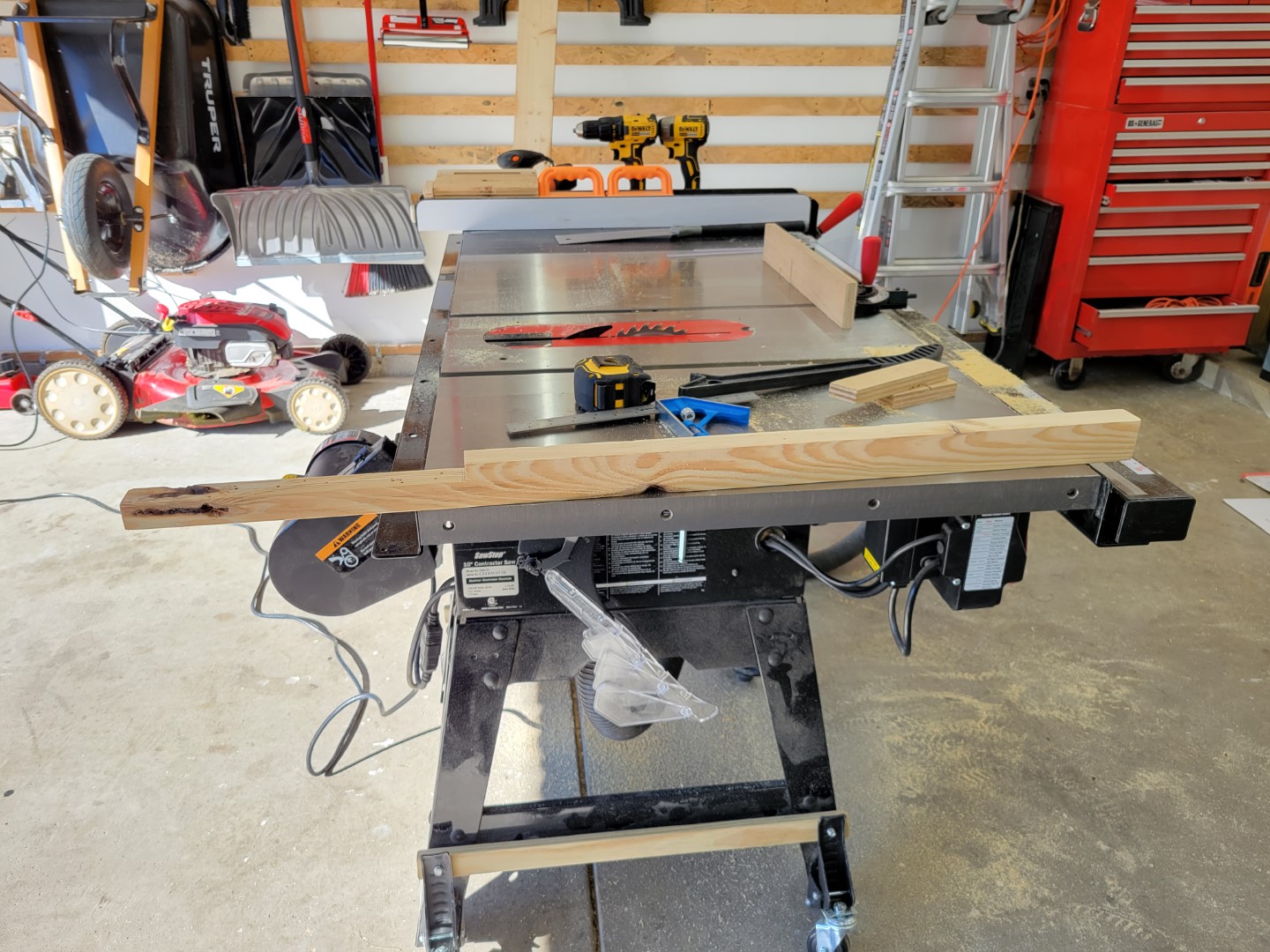
Drilled some holes for bolts and used a forstner bit to recess the bolt head to be flush with the surface.
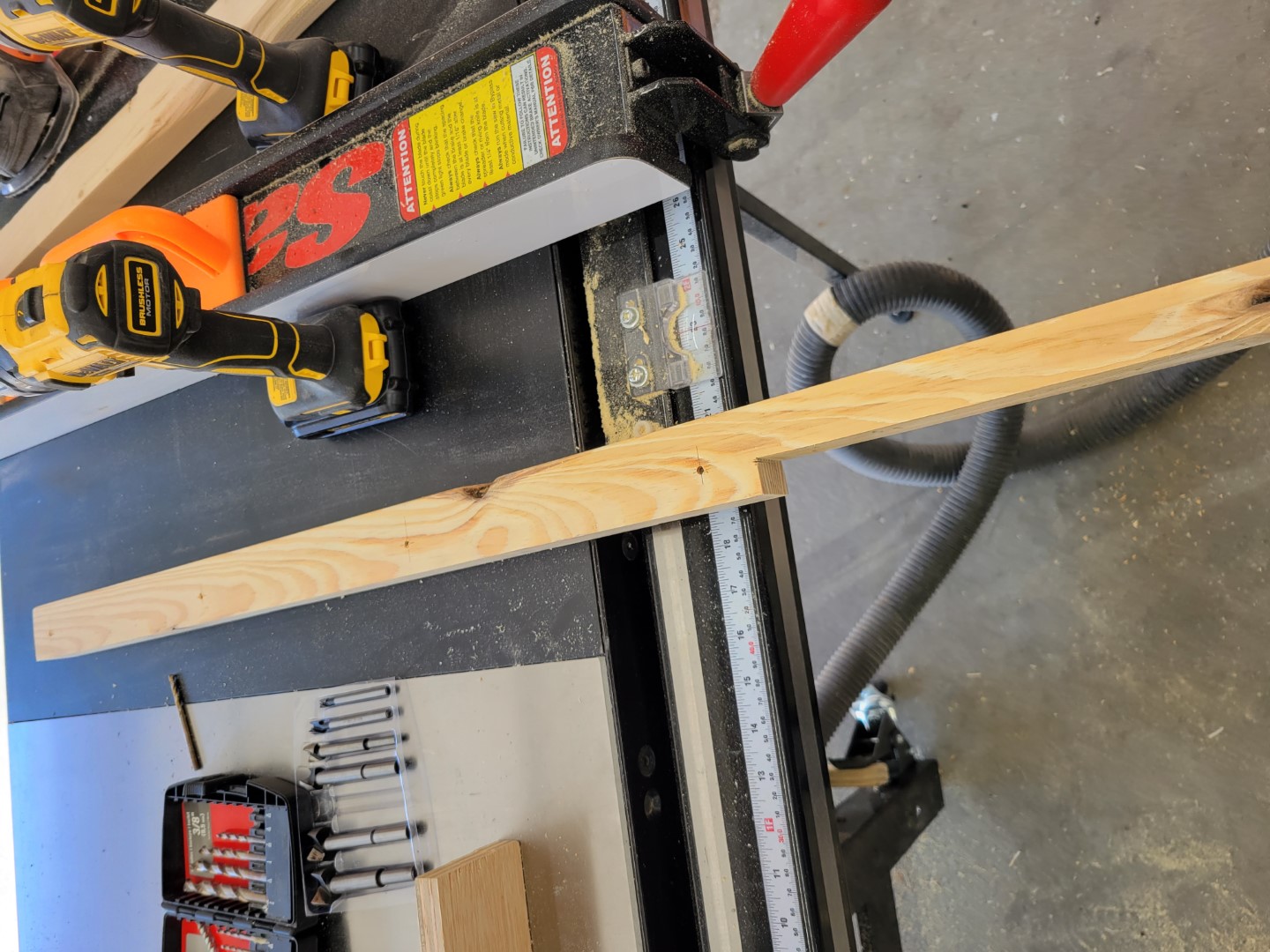
Right
On the right side, I mounted a board under with drywall screws instead of extending and drilling.
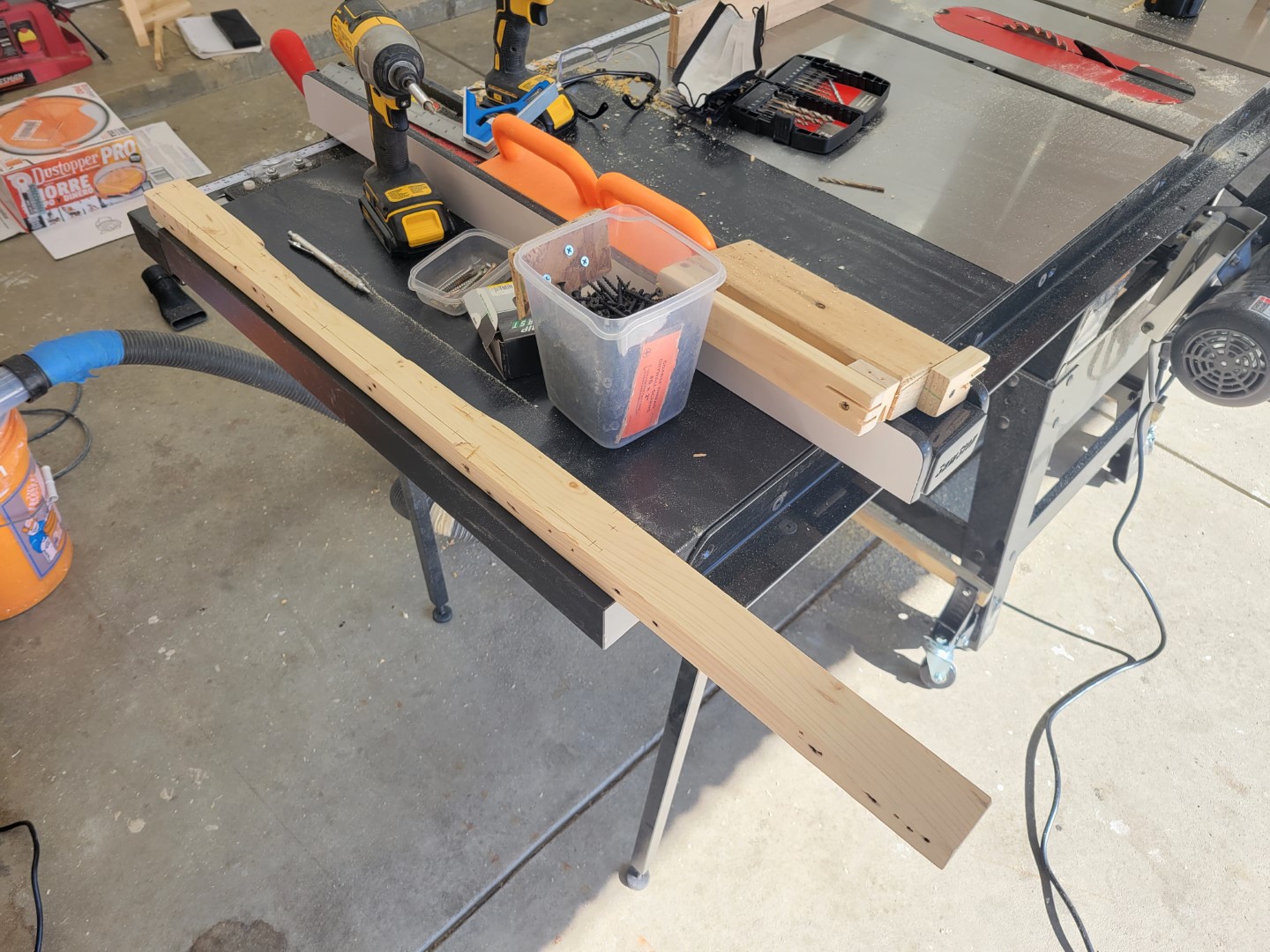
In hindsight, using the same strategy here as the left side and drilling some bolt holes would have made alignment of the back long boards more straightforward.
Inner rear
I used the existing hole in the rear rail to mount a board so that a piece of plywood would sit flush on top with the table. The rail was not perfectly level, so I had to shave down the board in multiple spots to get a truly flush fit. A hand plane would have made this go quicker, but some files and an electric sander got the job done.
I used a straight edge and a scrap piece of lumber to check the fit, making sure nothing sliding toward the rear would catch the lip of the extension table.
Needed to make a couple holes bigger to fit my bolts. Quick drilling fixed that.
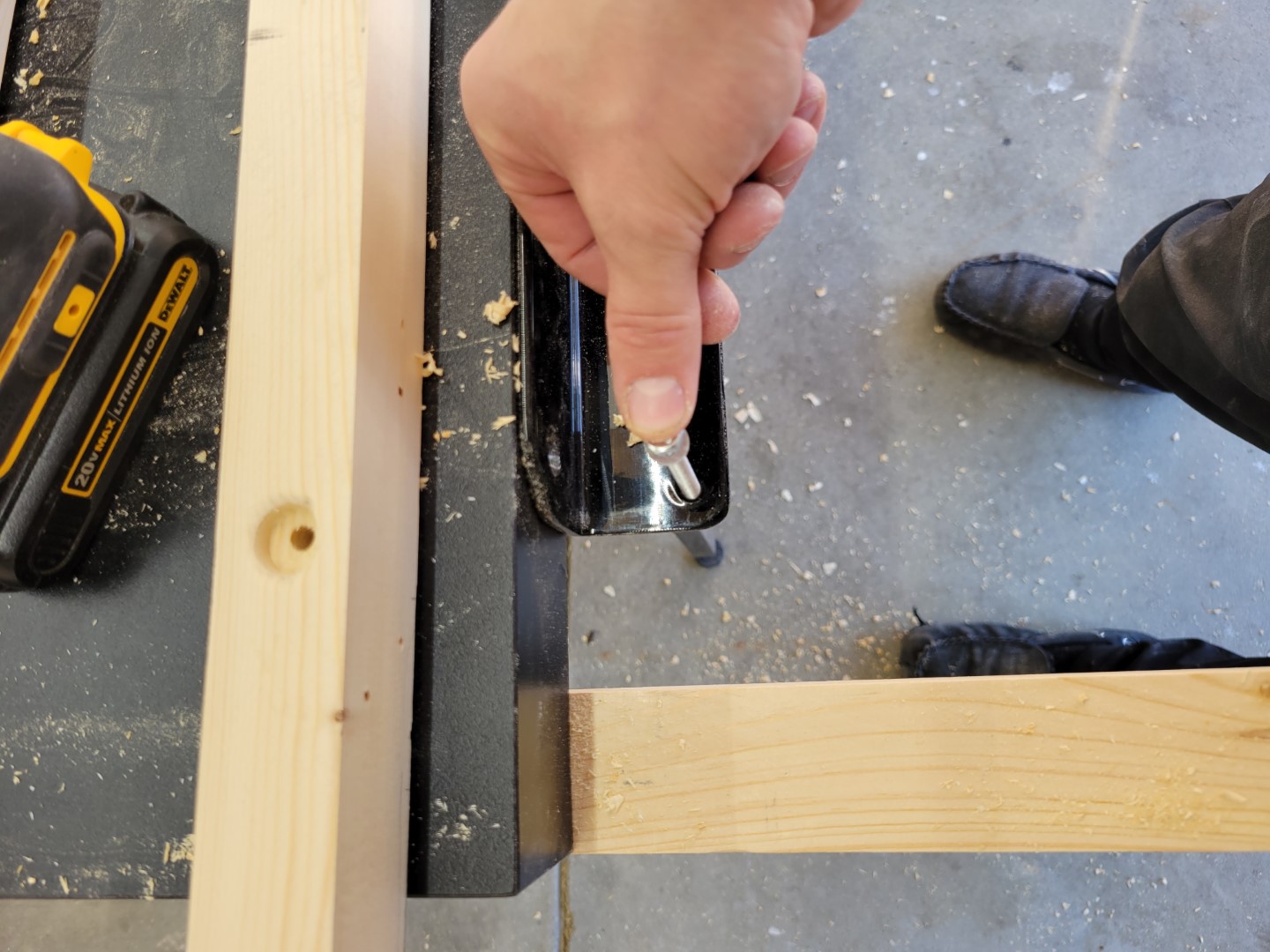
Outer rear
I used a roughly 1.5”x1.5” board to stretch across the back. This is where a problem from earlier showed up. Drilling a lag bolt to attach this, the knot from the left board showed how weak it was.
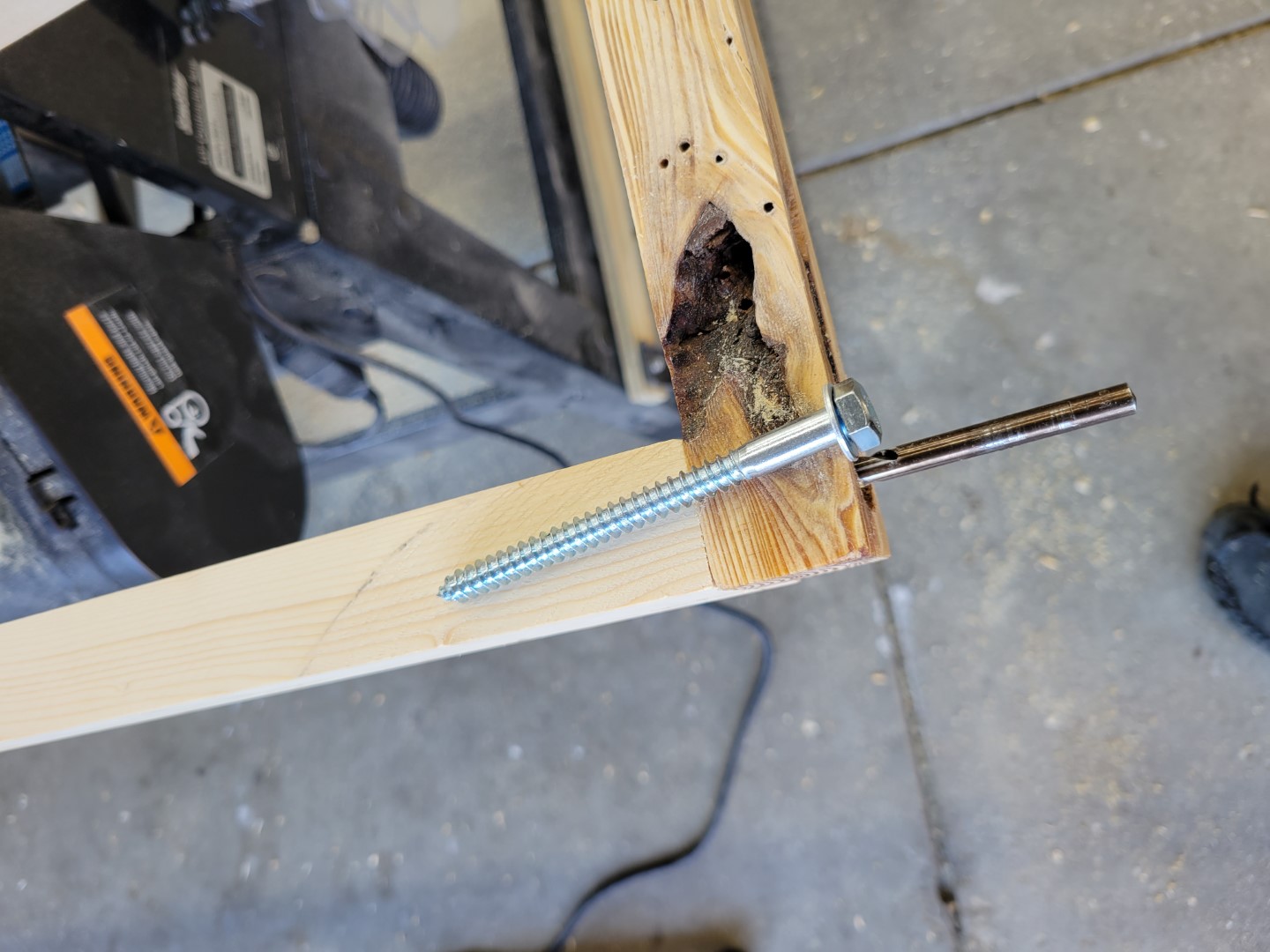
Because I couldn’t possibly admit my mistake and cut another one, I charged forward and reinforced with a second block between the long boards using pocket screws. I also packed the knot with wood glue and sawdust, thinking it’s better than nothing, but realistically probably adds 0.5% strength.
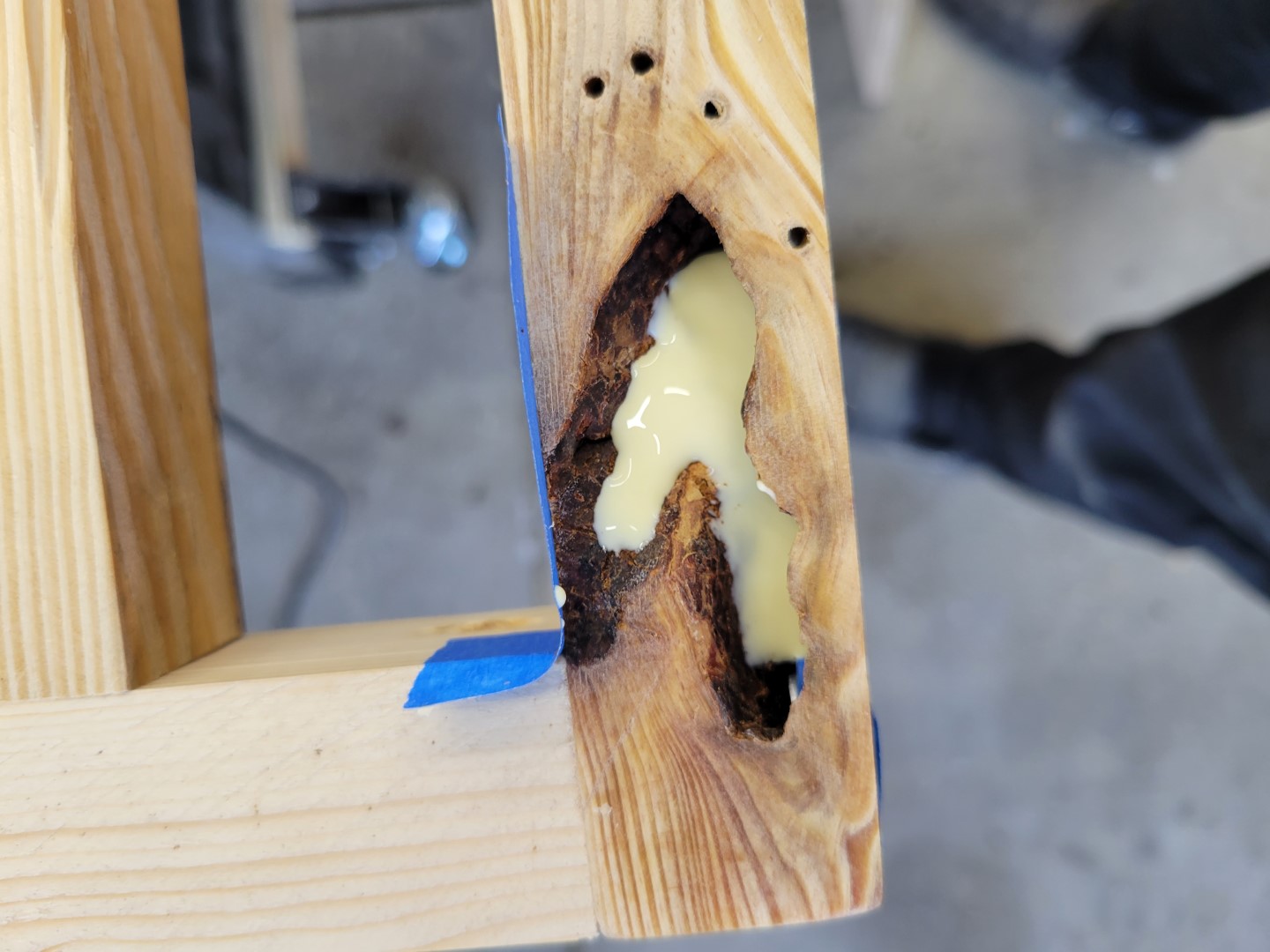

This took over 24 hours to dry. Probably not structural but it makes me feel better than having an empty hole.
Shaved and sanded flush.
Box frame
To enclose the motor, a box seemd like the simplest solution. It would have to enclose the motor through the range of tilt angles.
The bottom of the box to sit slightly below the saw body, which means I would have to deal with the angled legs.
The motor extends well past the saw body on the right side, so a box would have to extend past and wrap back around. Because the bottom reaches below the saw body, the angled legs show up on this face.
The left side of the box could potentially be coplanar with the left side of the saw body, but the mounting options there were limited because of the existing bolts.
To address all of these problems, the easist way I could think of was to create a frame that sits shy of the saw and lets me mount some 1/8” stock and cope it against all of the saw’s angles. Much easier to be precise with some leftover cardboard stock than thicker wood.
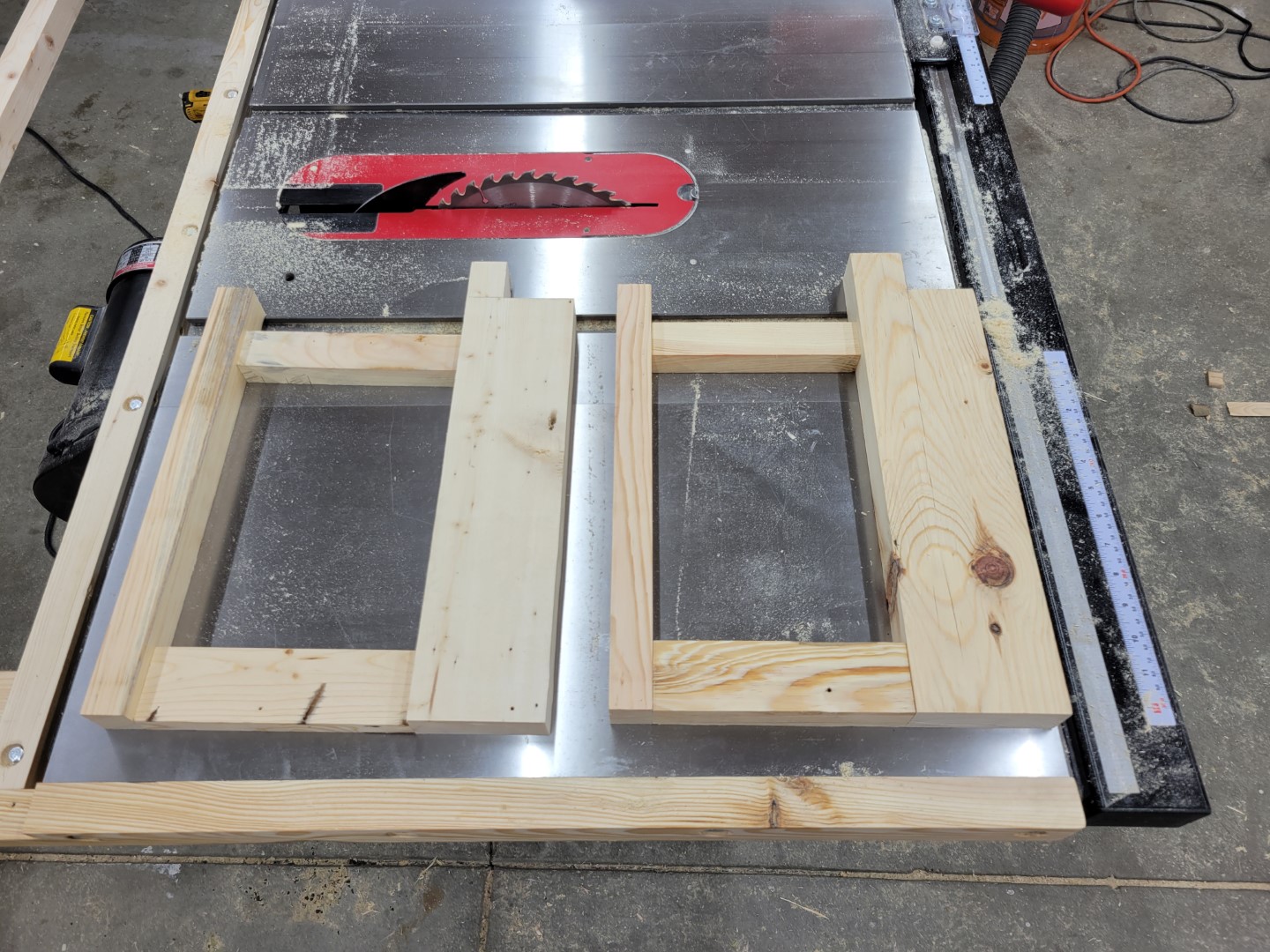
The side closer to the saw is thicker so I could leave a lip to mount it to the frame rail board.

Pocket screws were my answer to joinery here.
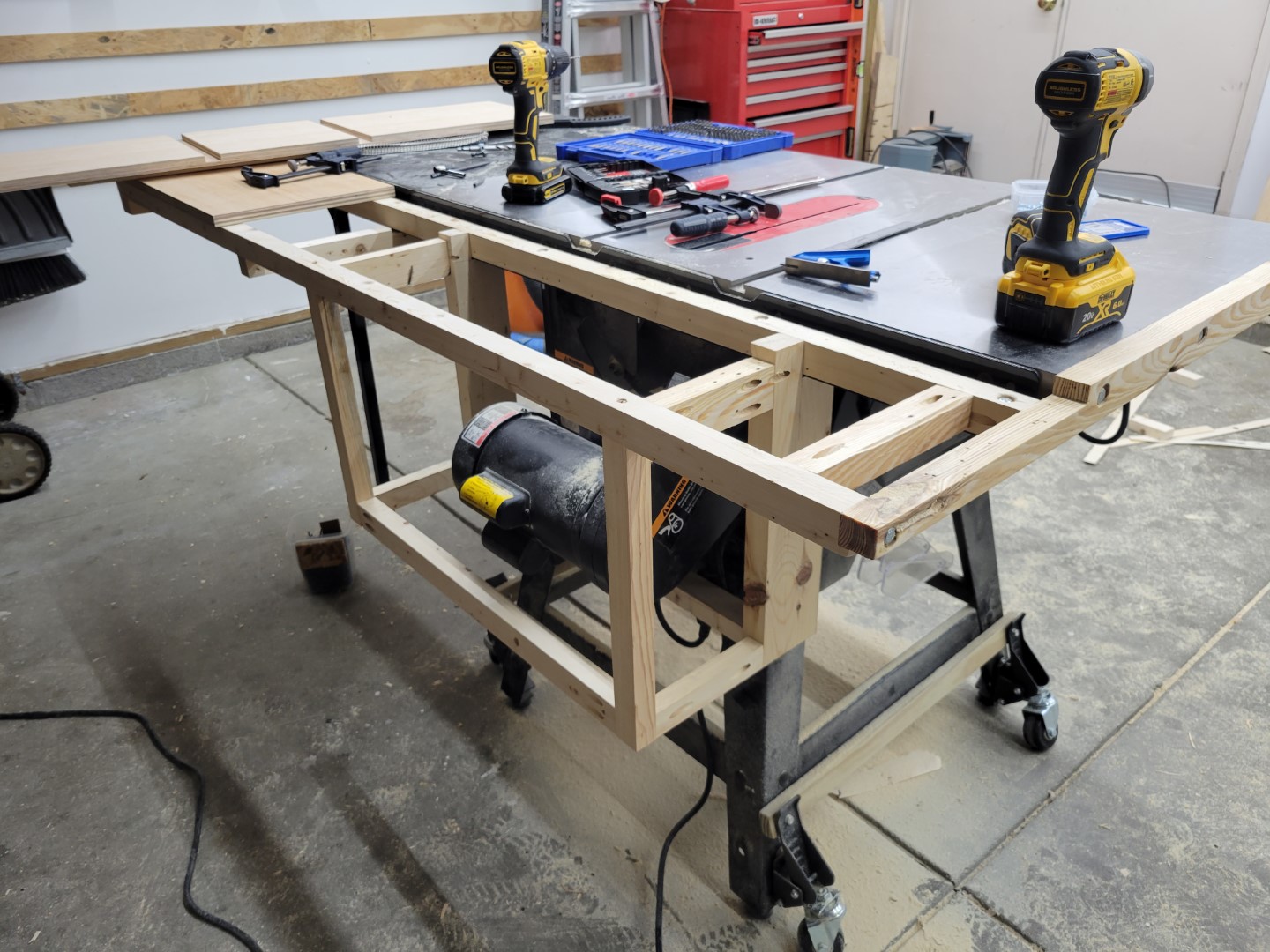
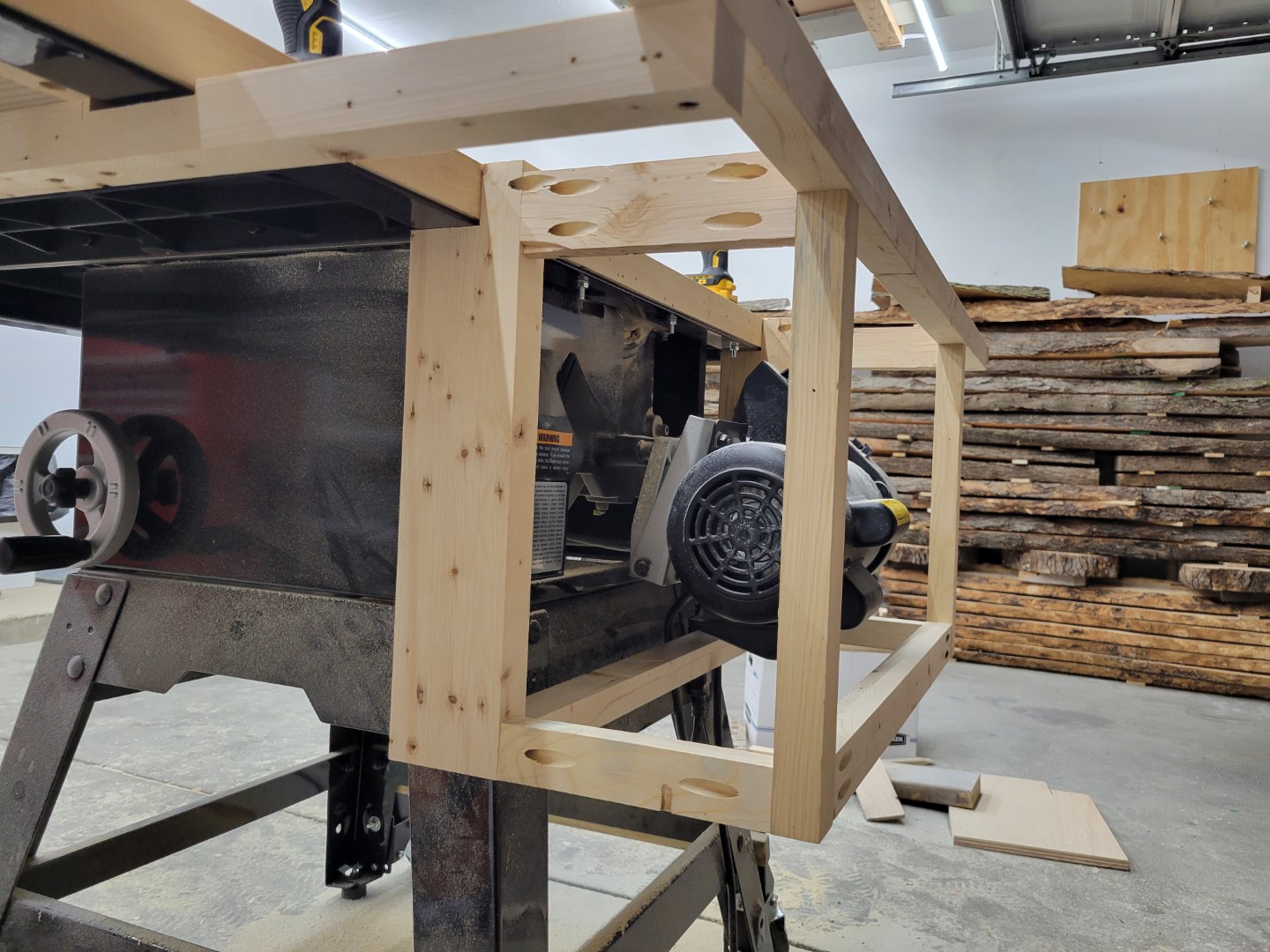
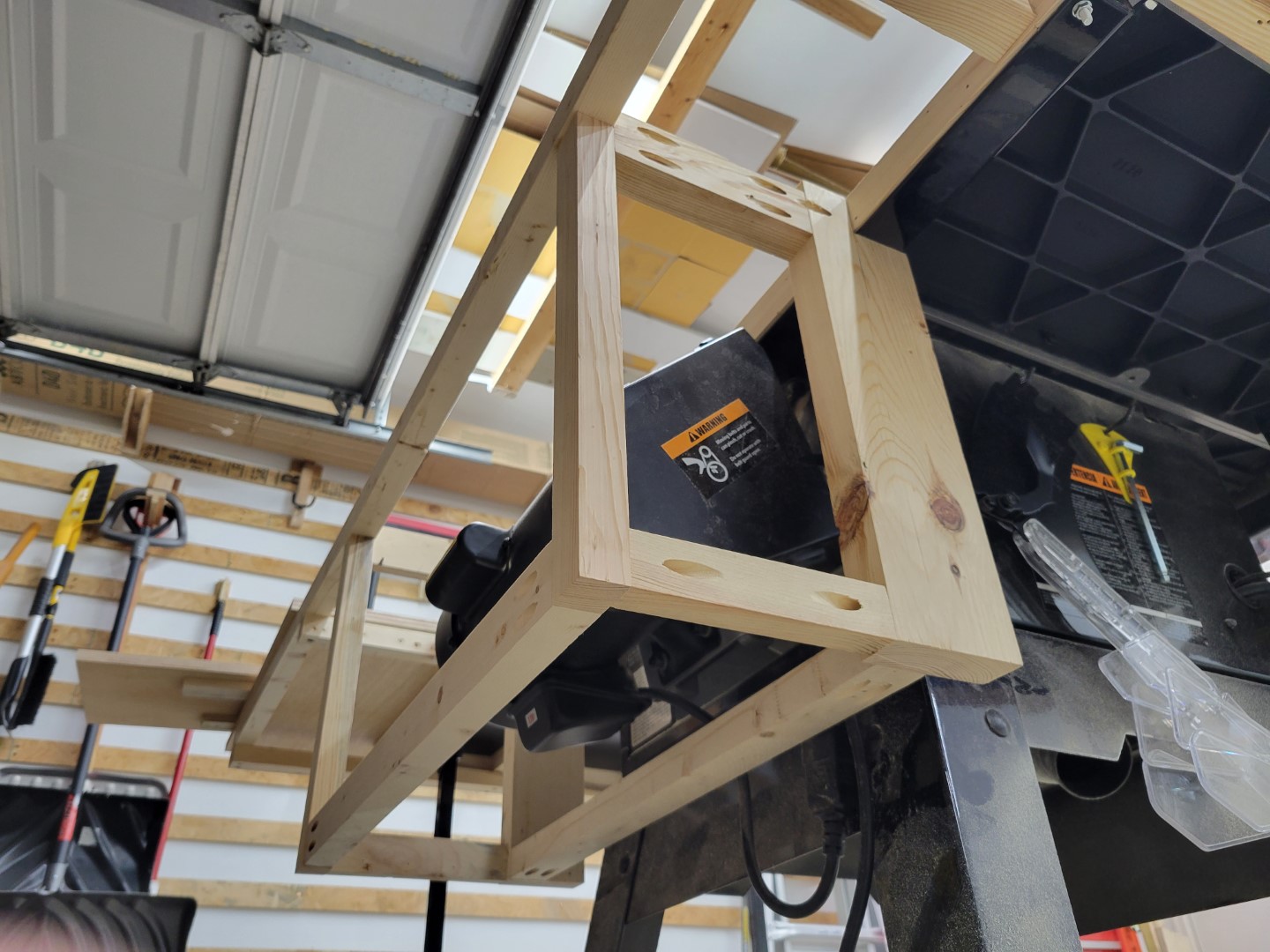
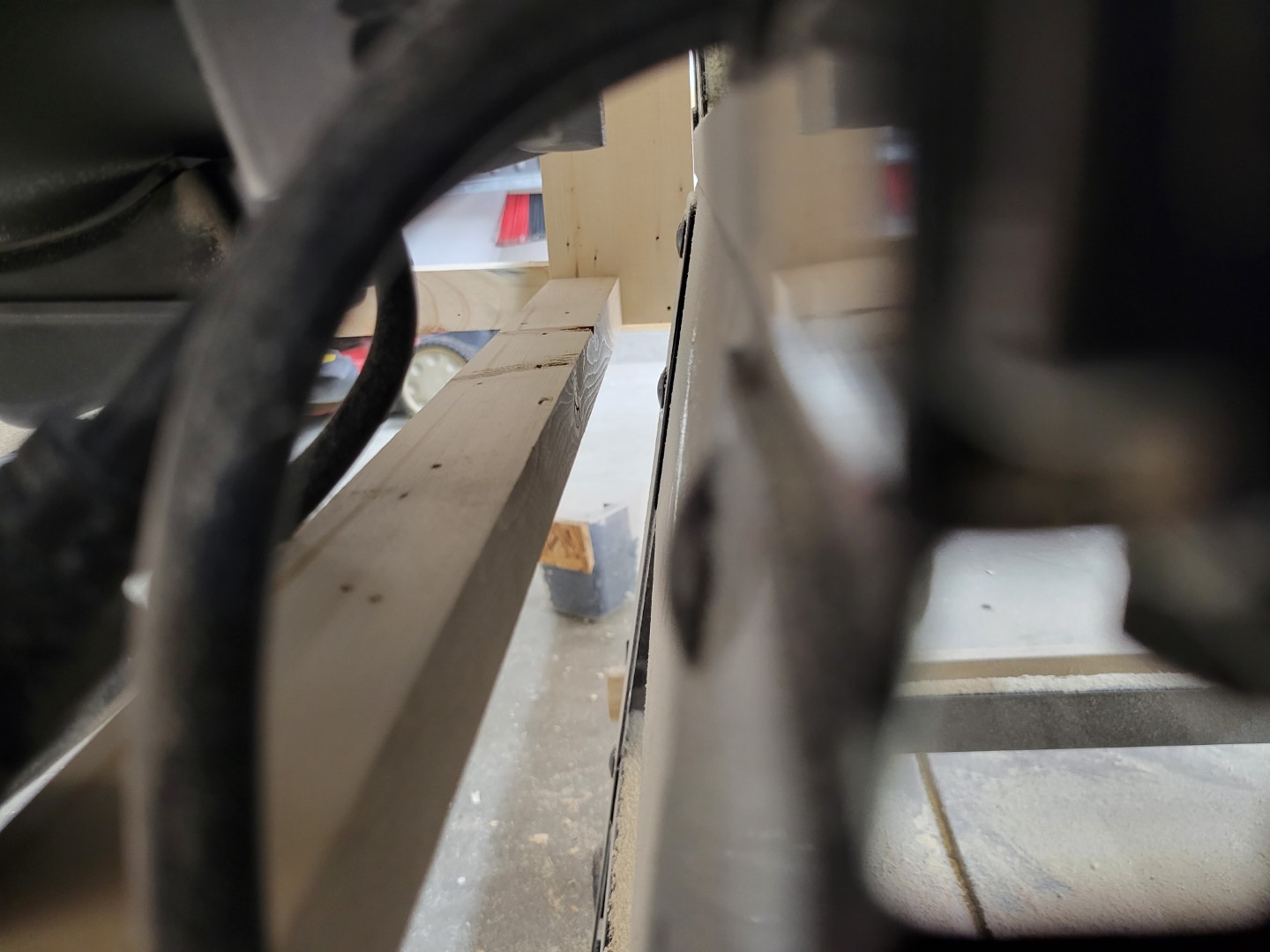
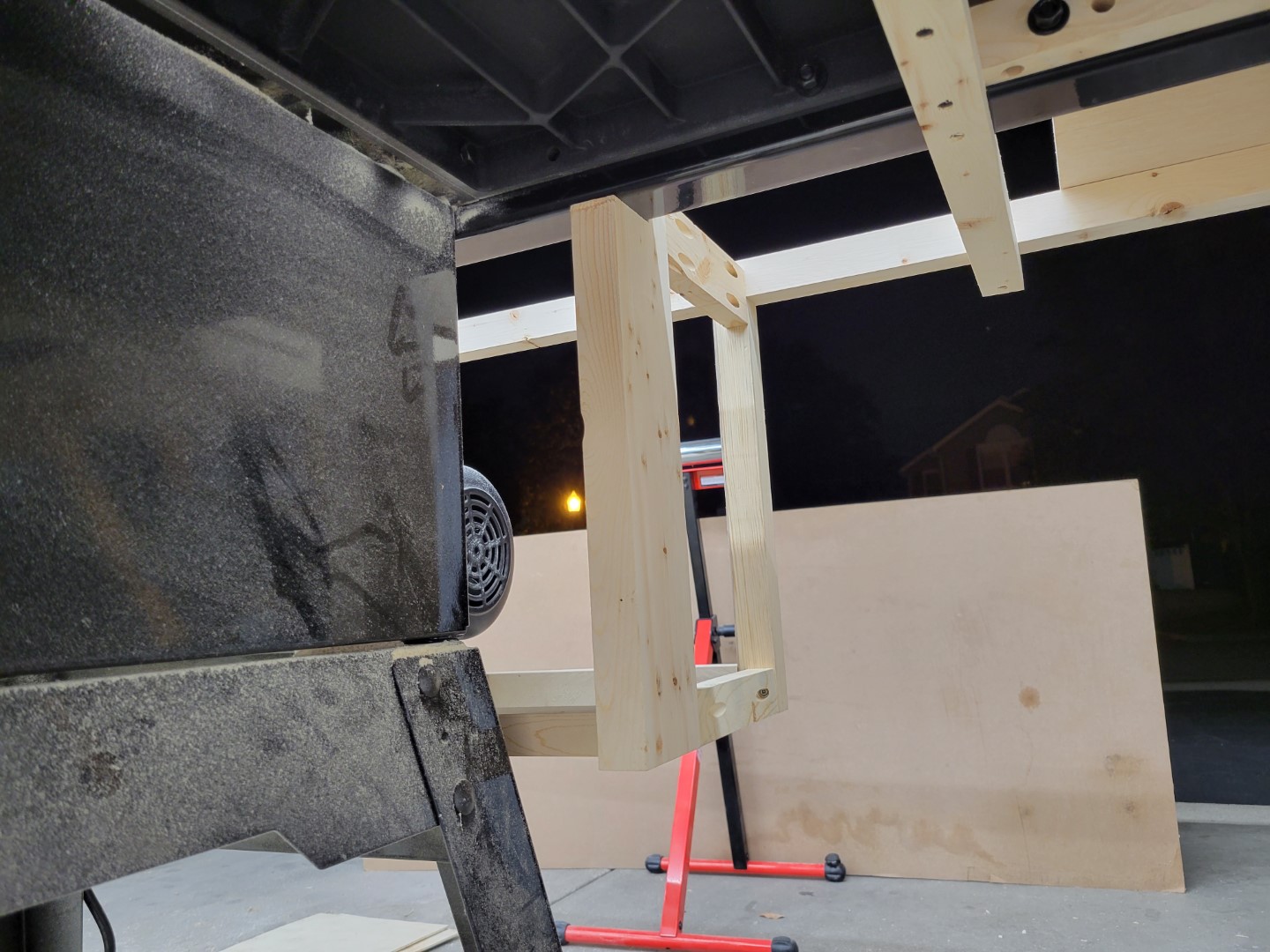
Now to sew it up with leftover thin fiberboard material.
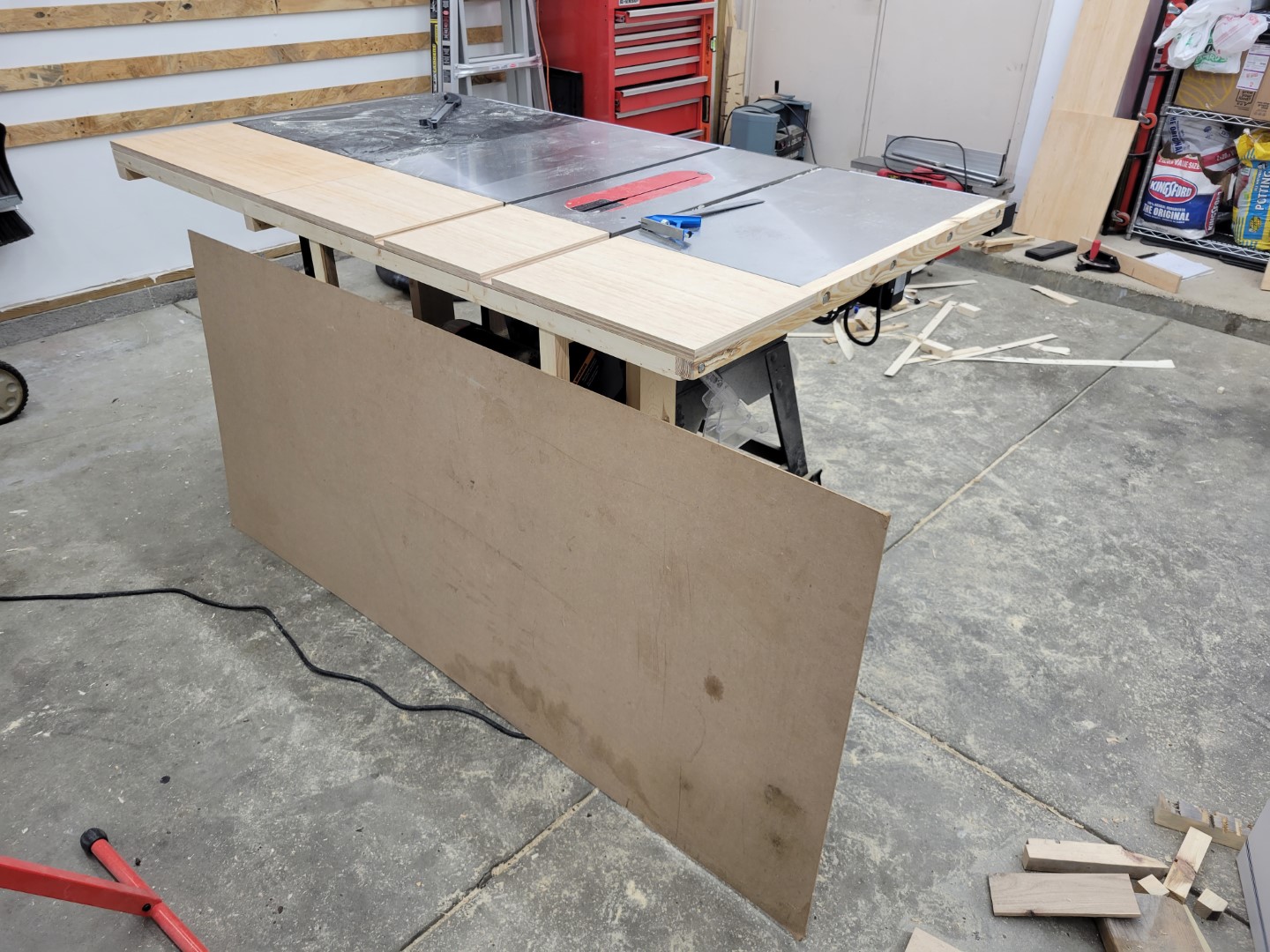
Left side coped out
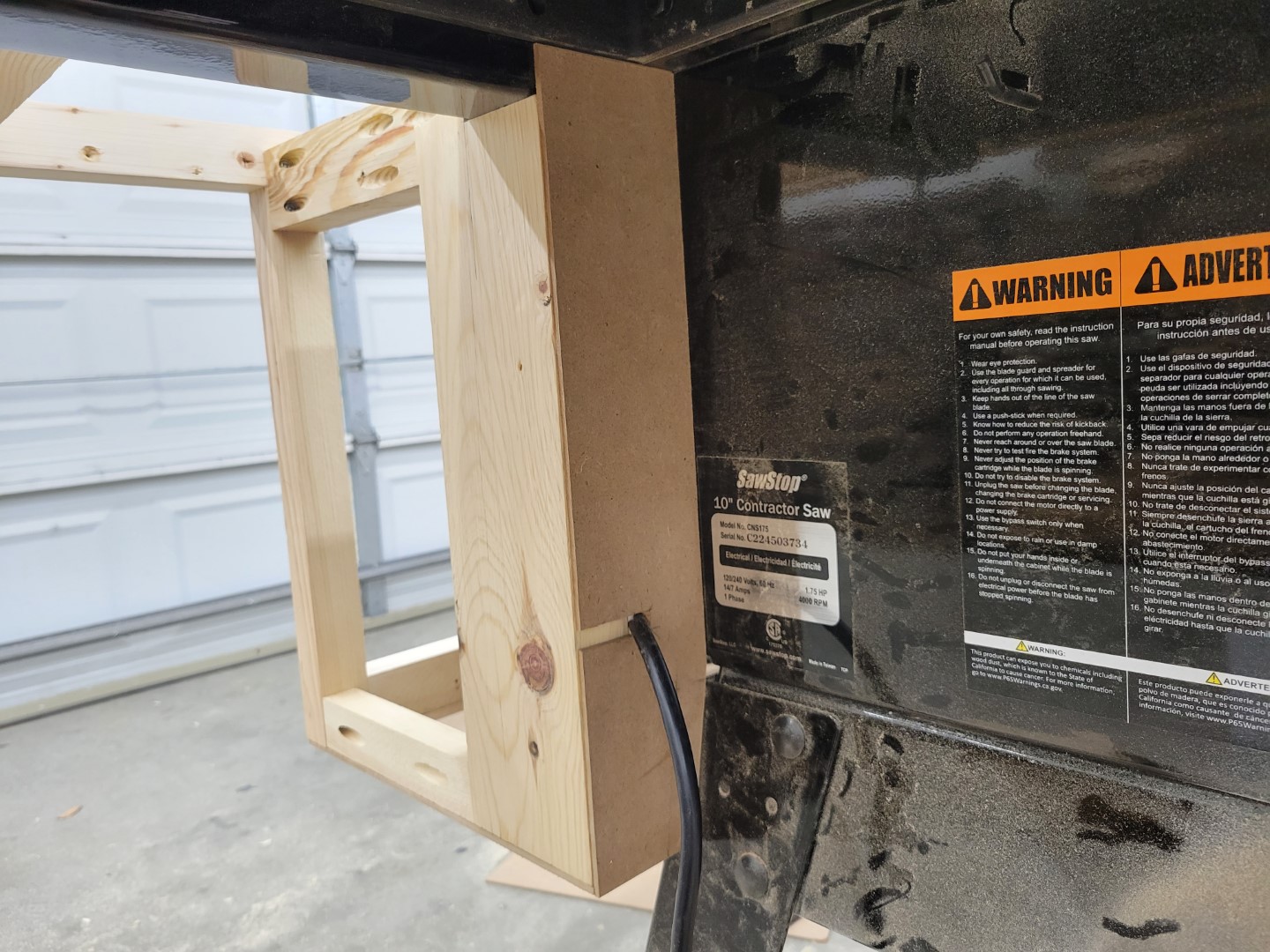
Bottom coped out
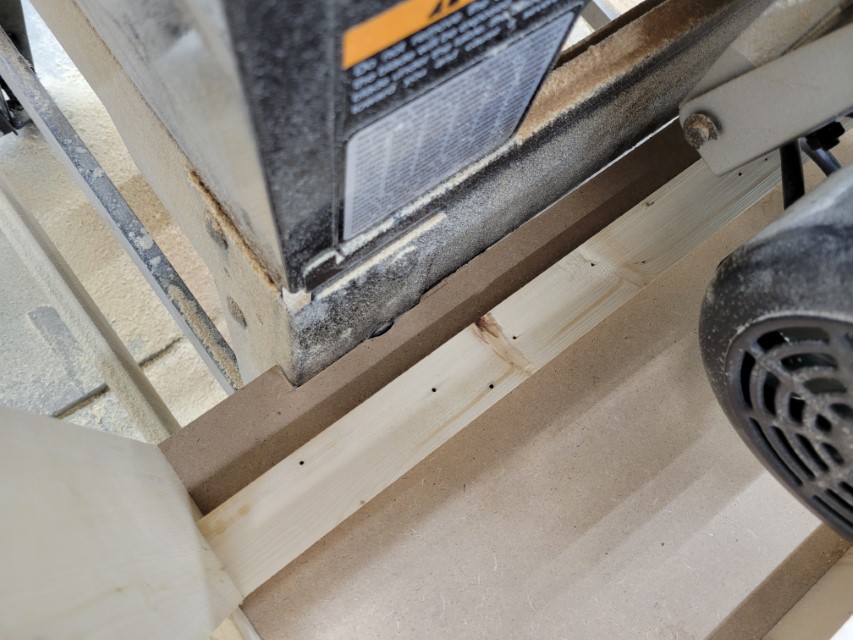
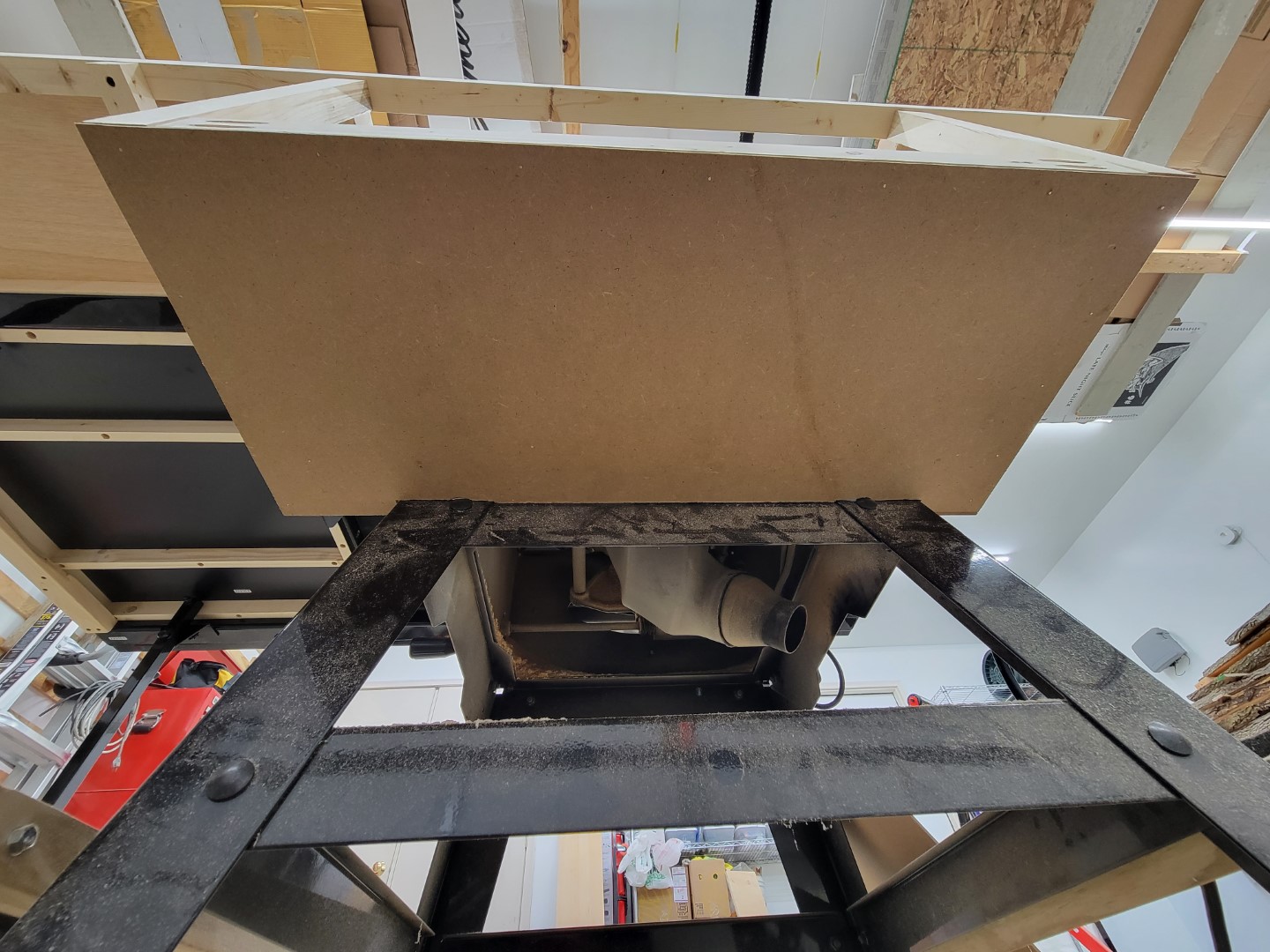
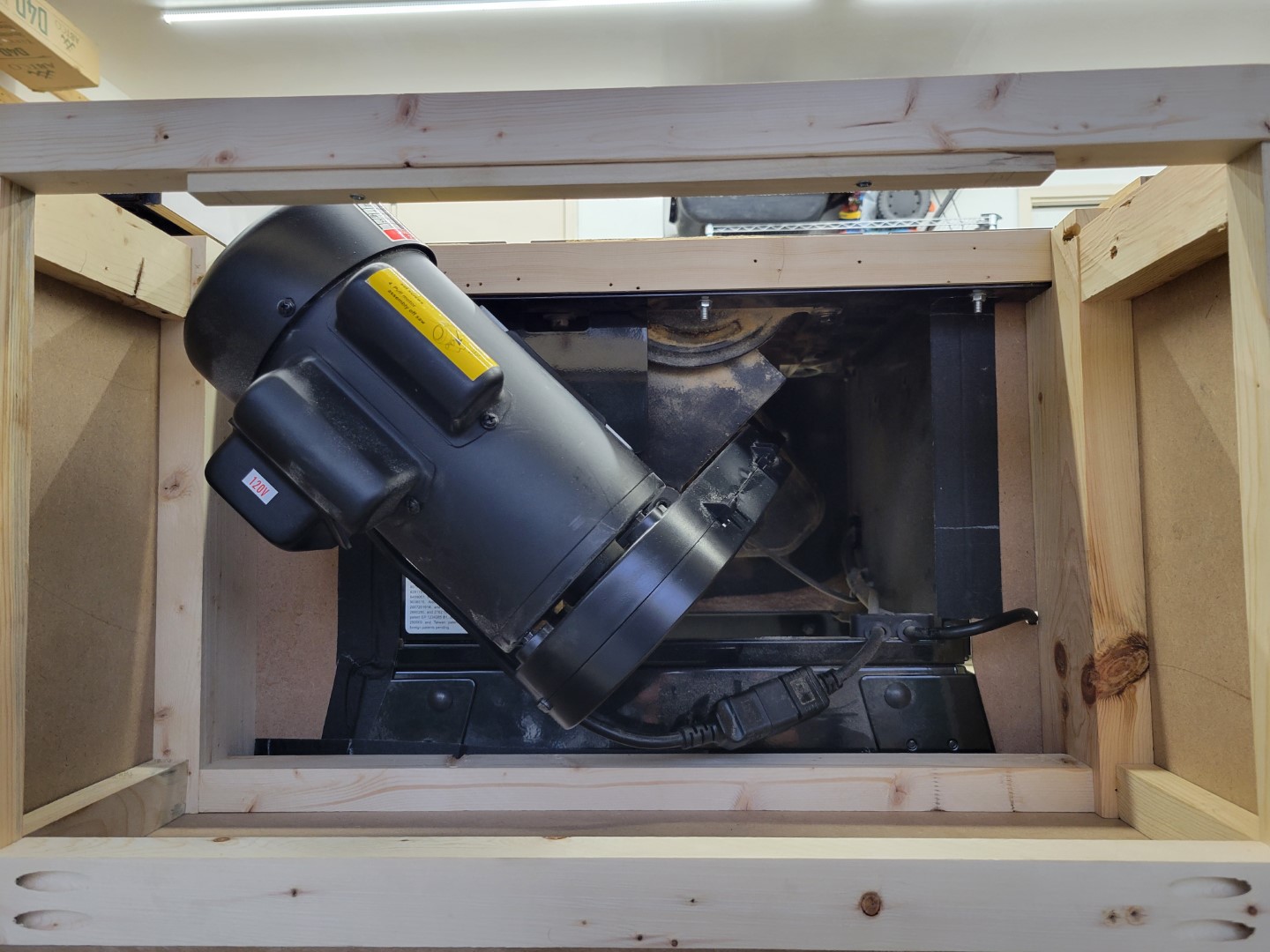
I attached the fiberboard to the frame with a generous amount of brads left over from another project.
To fully seal the gaps, needed to use caulk or tape. I chose tape. Everyone knows my caulk skills are limited.
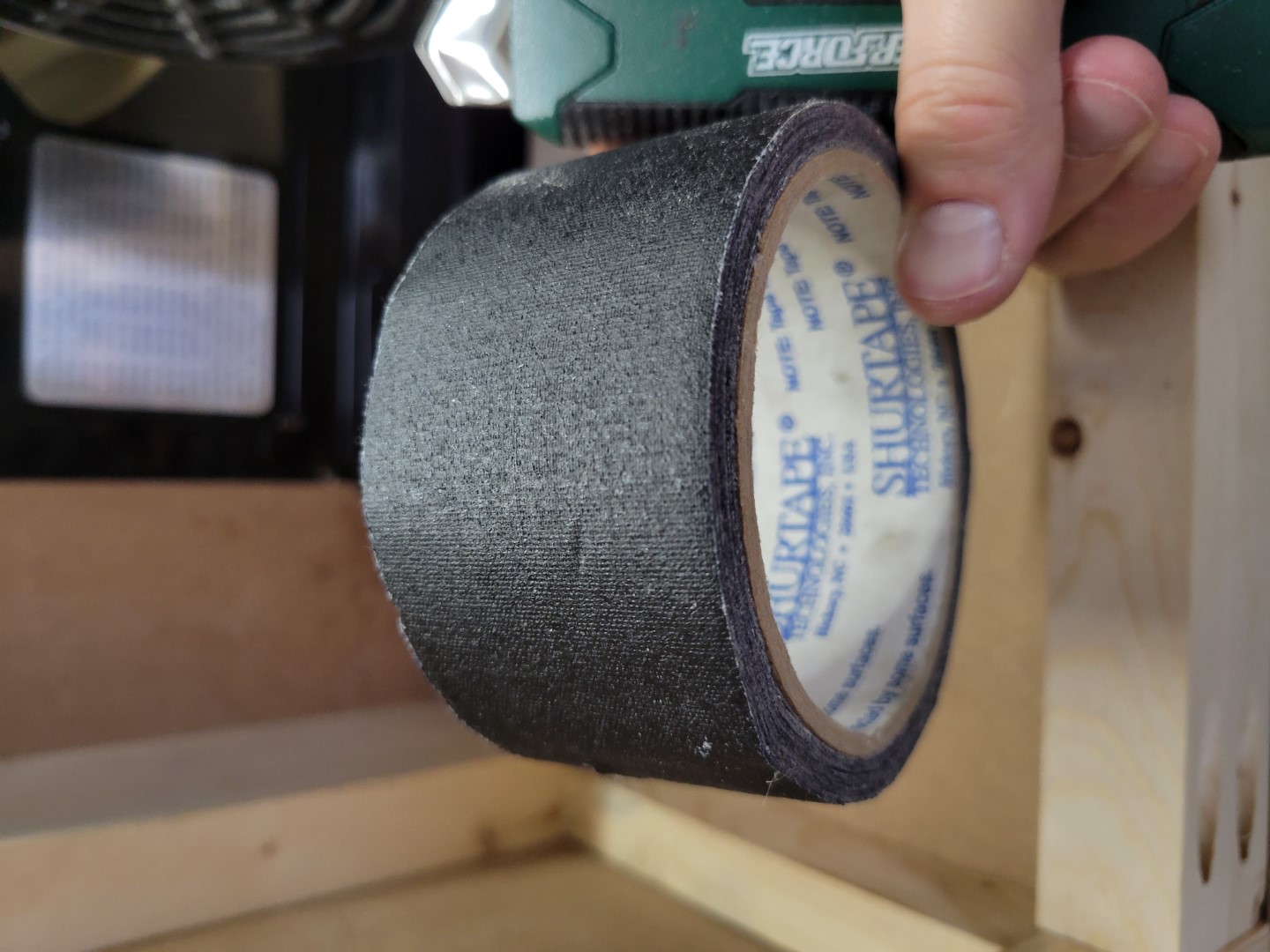
I’ve had this tape forever, it’s pretty sturdy. Covered up all of the visible gaps from the inside where the fiberboard meets the saw.
Sealing up the back was the last step. I added a support lip at the top to keep the fiberboard sheet from bending in. Then four screws so I could easily remove this to access the motor and body.
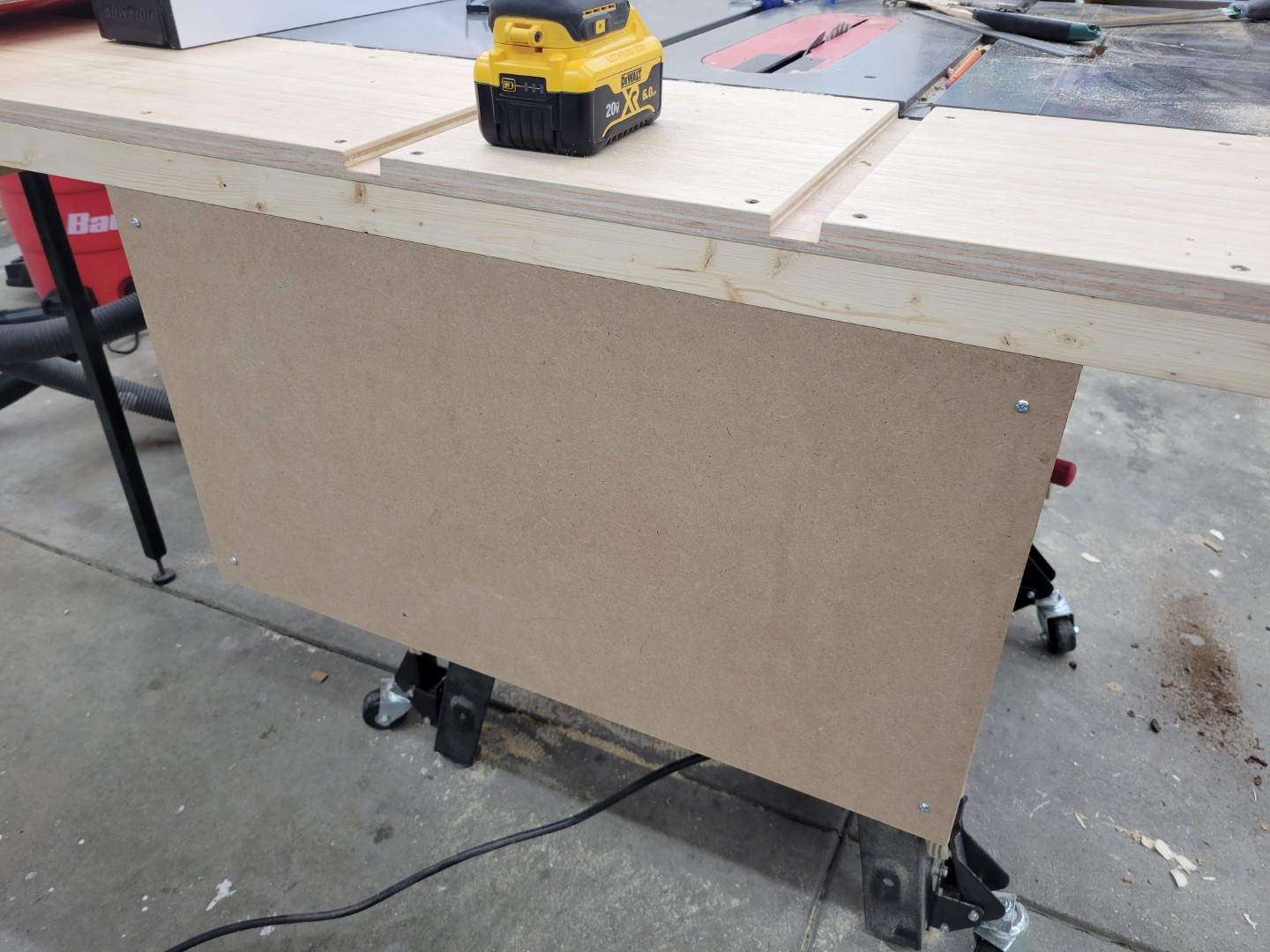
Plywood surface
I had some plywood scrap but not long enough for the full width. So I went ahead and ripped the sheet the wrong direction and immediately face-palmed. The grain was running perpendicular to the cutting direction, which probably adds some friction.
Still, I moved ahead. I didn’t want to stitch the surface together from three pieces for the grain to be correct.
The next problem is that at 45, the motor bumps into the bottom of this face.
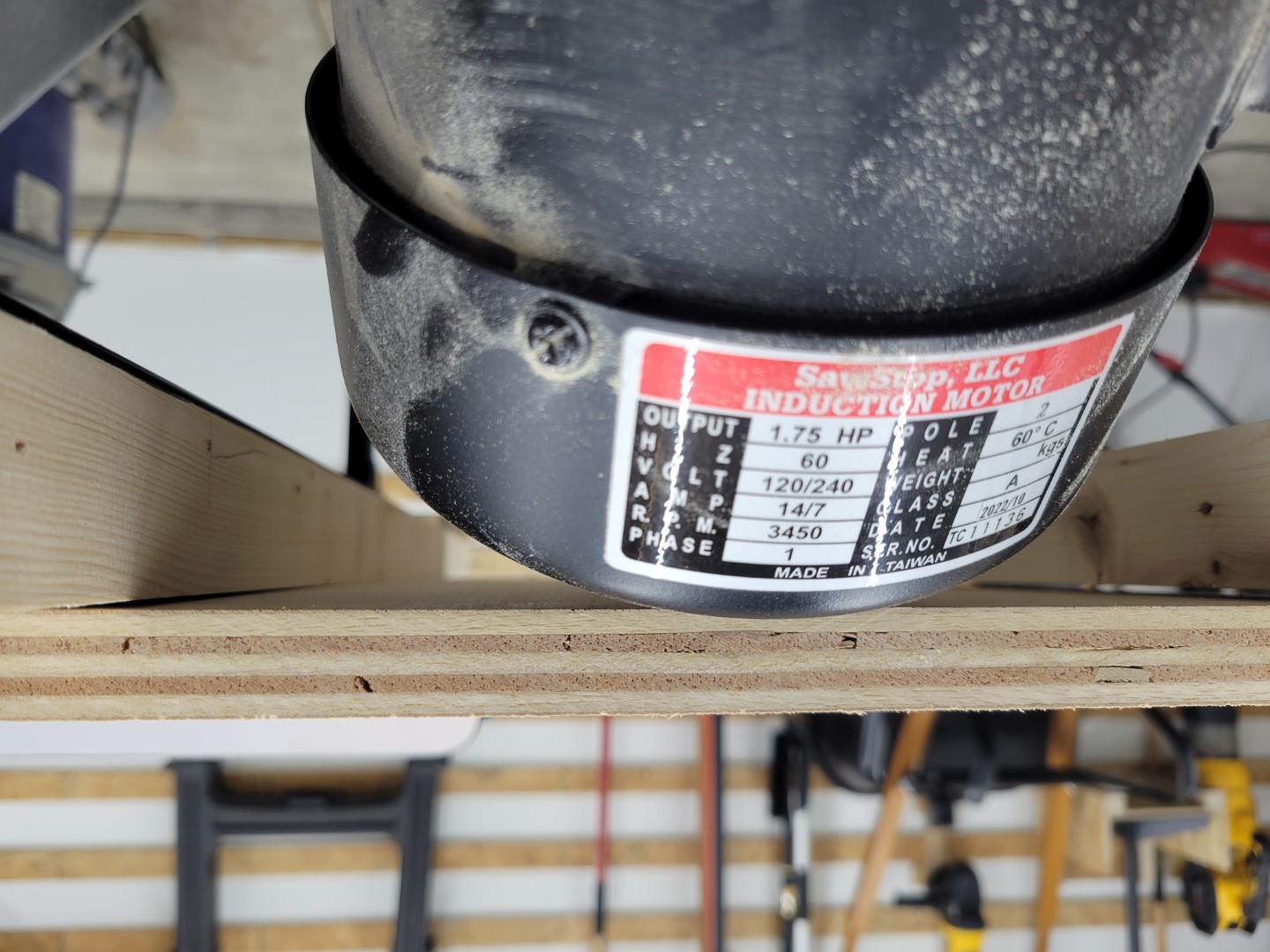
A Forstner bit and a chisel solved this.
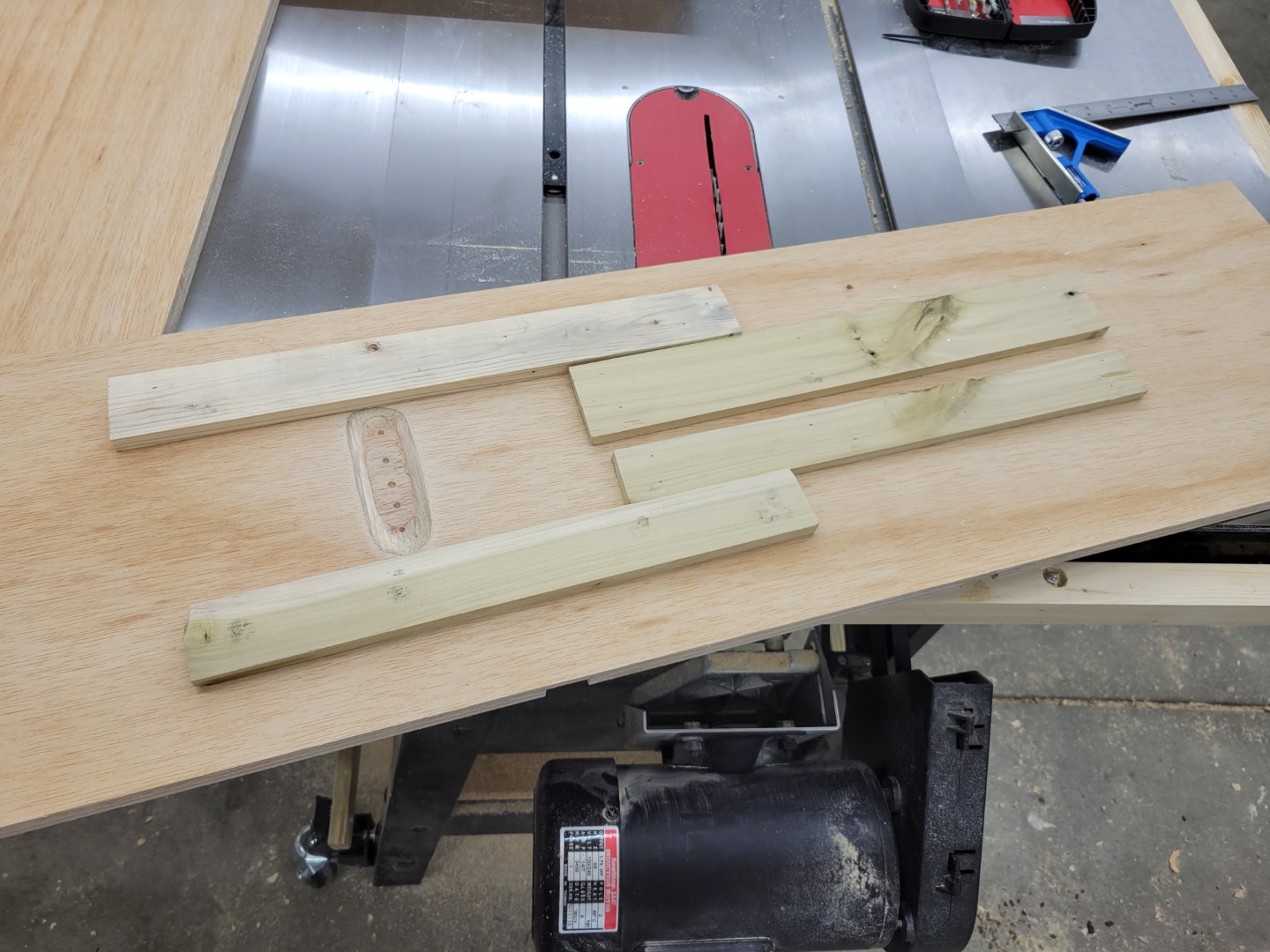
This also shows some reinforcement I carefully added from scraps using glue and brads. The grooves I cut for the miter slot felt too thin and weak.
My carefully added scraps caused two problems later: clearance when sitting in my frame, and clearance with the box enclosure I added later. Both problems were solved with a hand saw and chisel. Hinsight, should have added these at the end.
I gave the plywood a generous couple coats of paste wax, and that makes it smooth enough despite cutting the grain the wrong way.
Open height adjustment knob and tilt angle indicator
This knob adjusts the height of the saw, and moves side to side to indicate the angle. Others solved this problem with magnets and acrylic, but I’m cheap and don’t have either of those. I also wanted this to be a zero-effort solution when using the saw, so moving a piece when adjusting the angle was right out.
The angle indicator is slightly useful despite its limited accuracy, so I wanted to keep it that way.
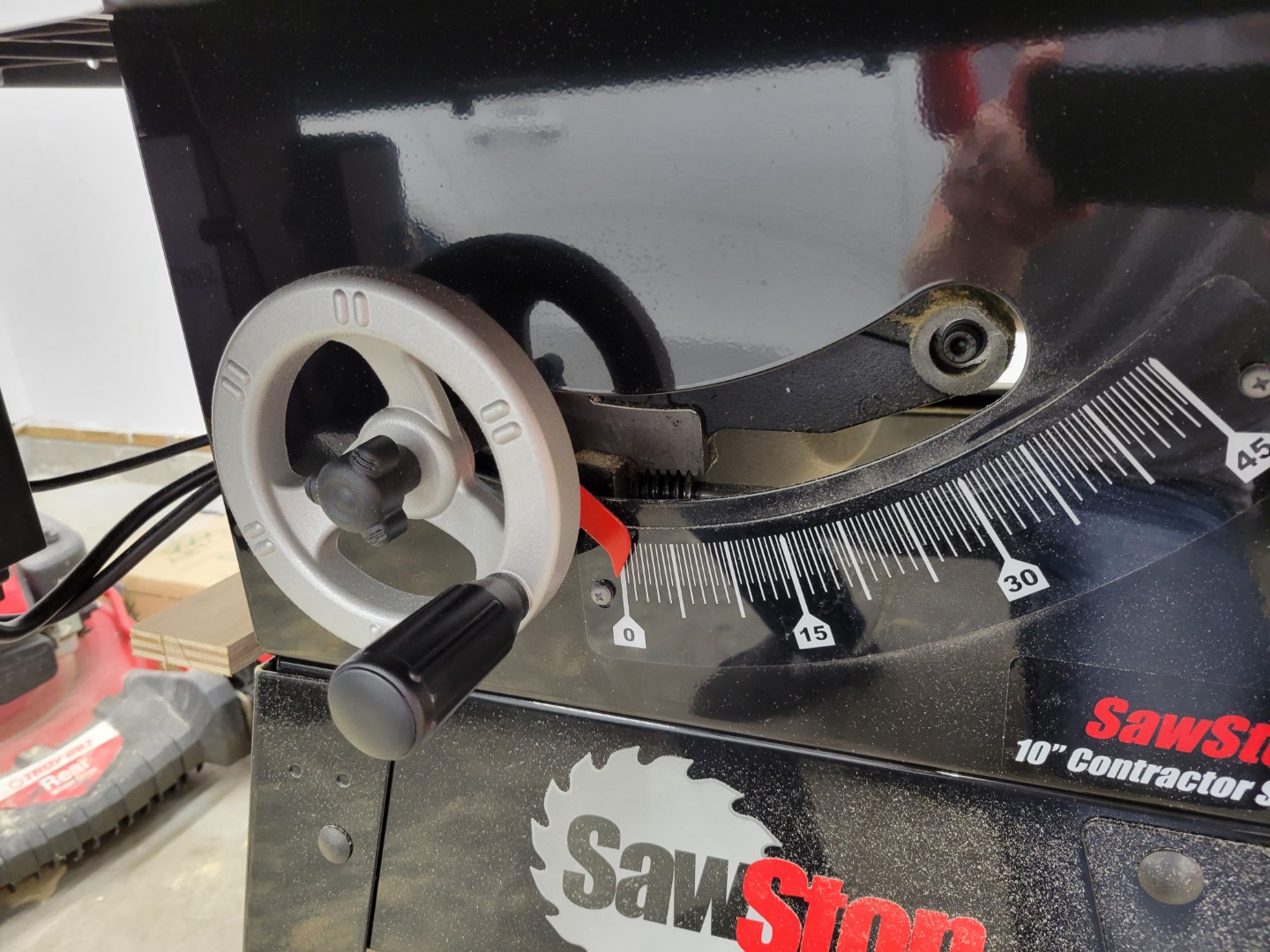
I had this foam window seal that didn’t work for the reason I bought it.
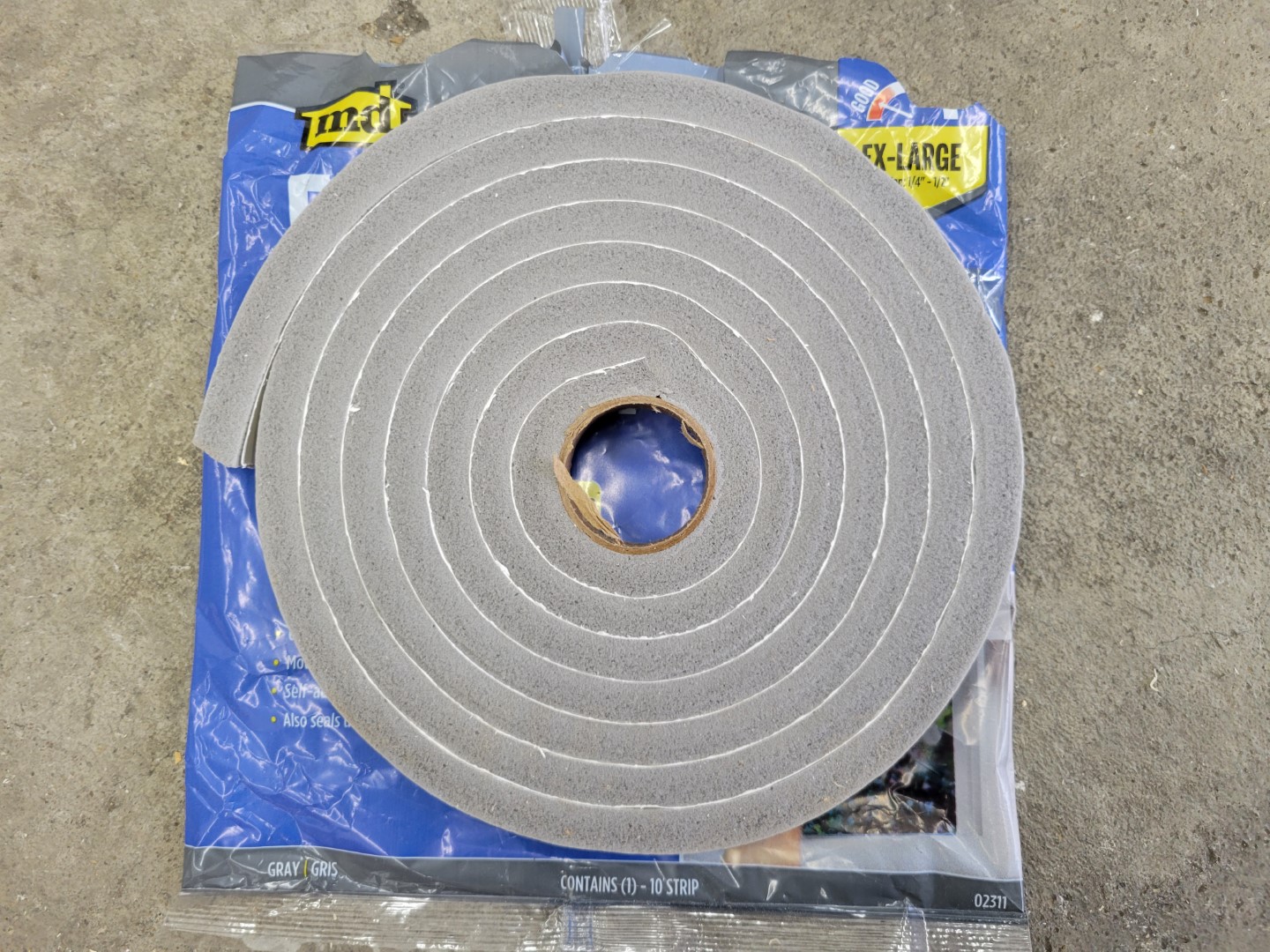
But it fit under the angle indicator with a couple washers added to offset.
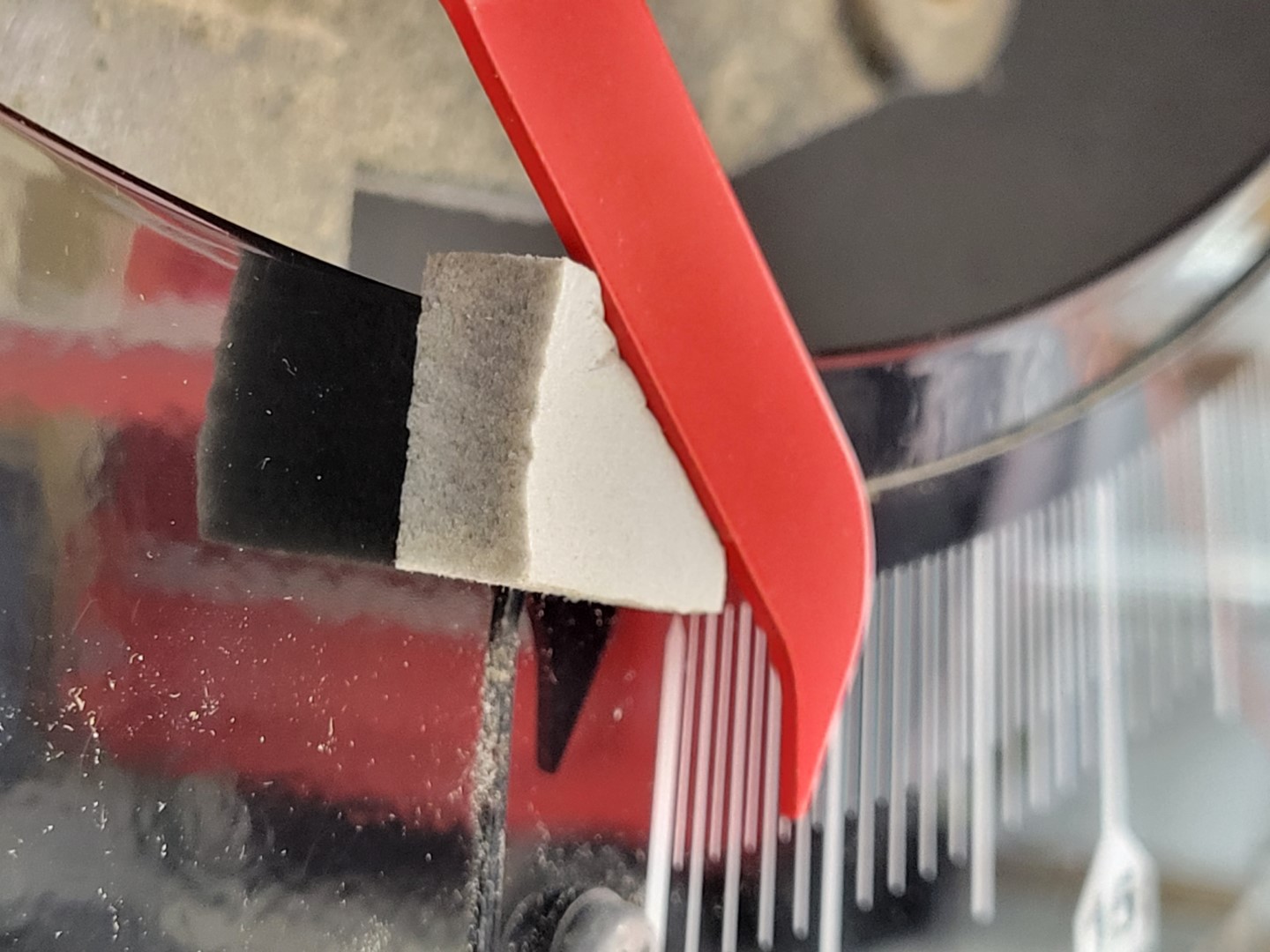
Some carboard tracing and experimentation showed me it was possible to have a piece attached to the knob that fully covered the gap at both 0 and 45.
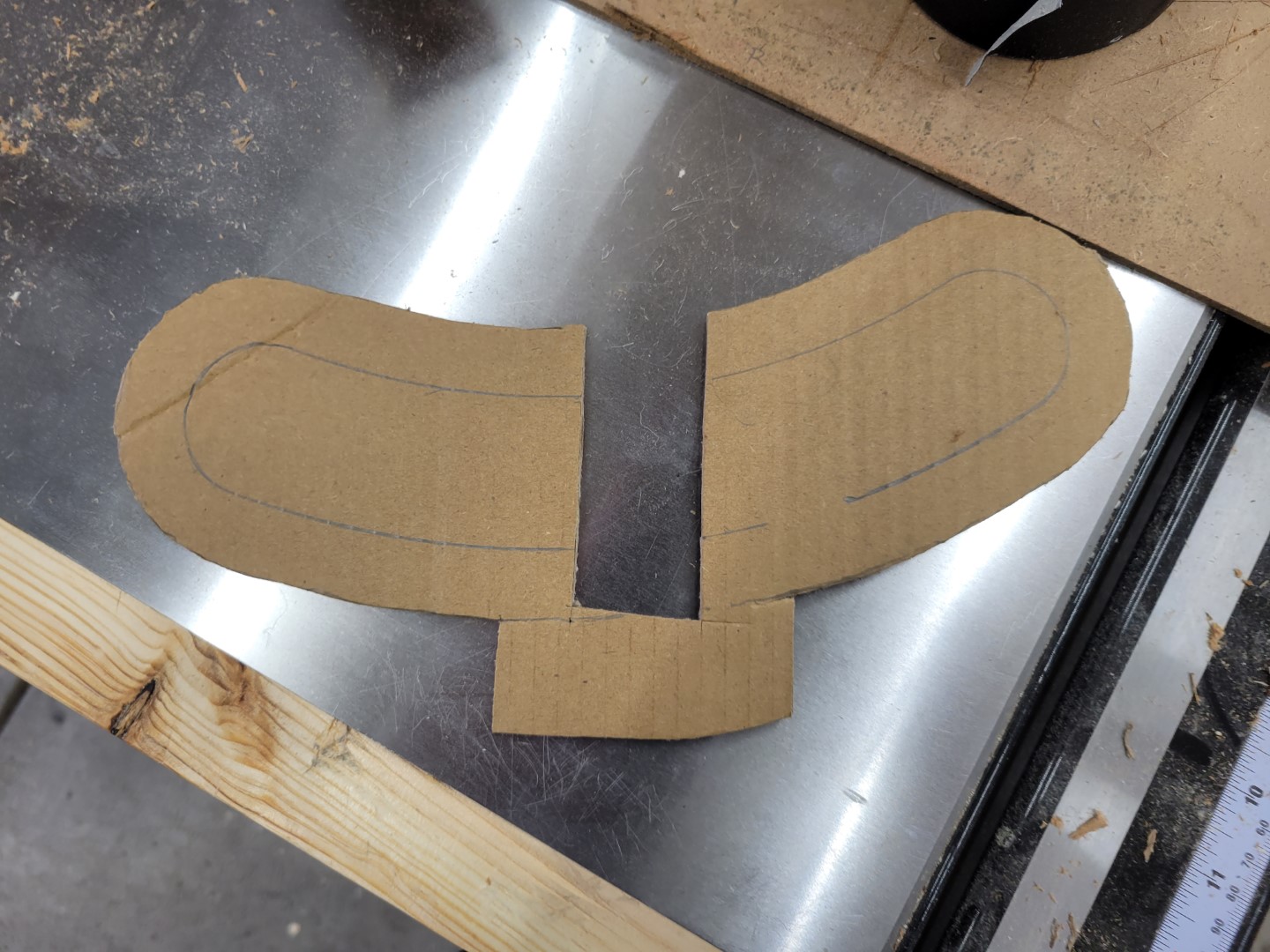
For the recruiters: I used rapid iteration with a cost-effective prototype to find a right-sized solution that addressed all of the client’s edge cases. I was able to scale the solution to a production-ready product that was more robust than the prototype with minimal investment. Achieved 100% client satisfaction with 0 user complaints.
For the engineers: I played with cardboard until it worked, then repeated with thicker, stronger cardboard.
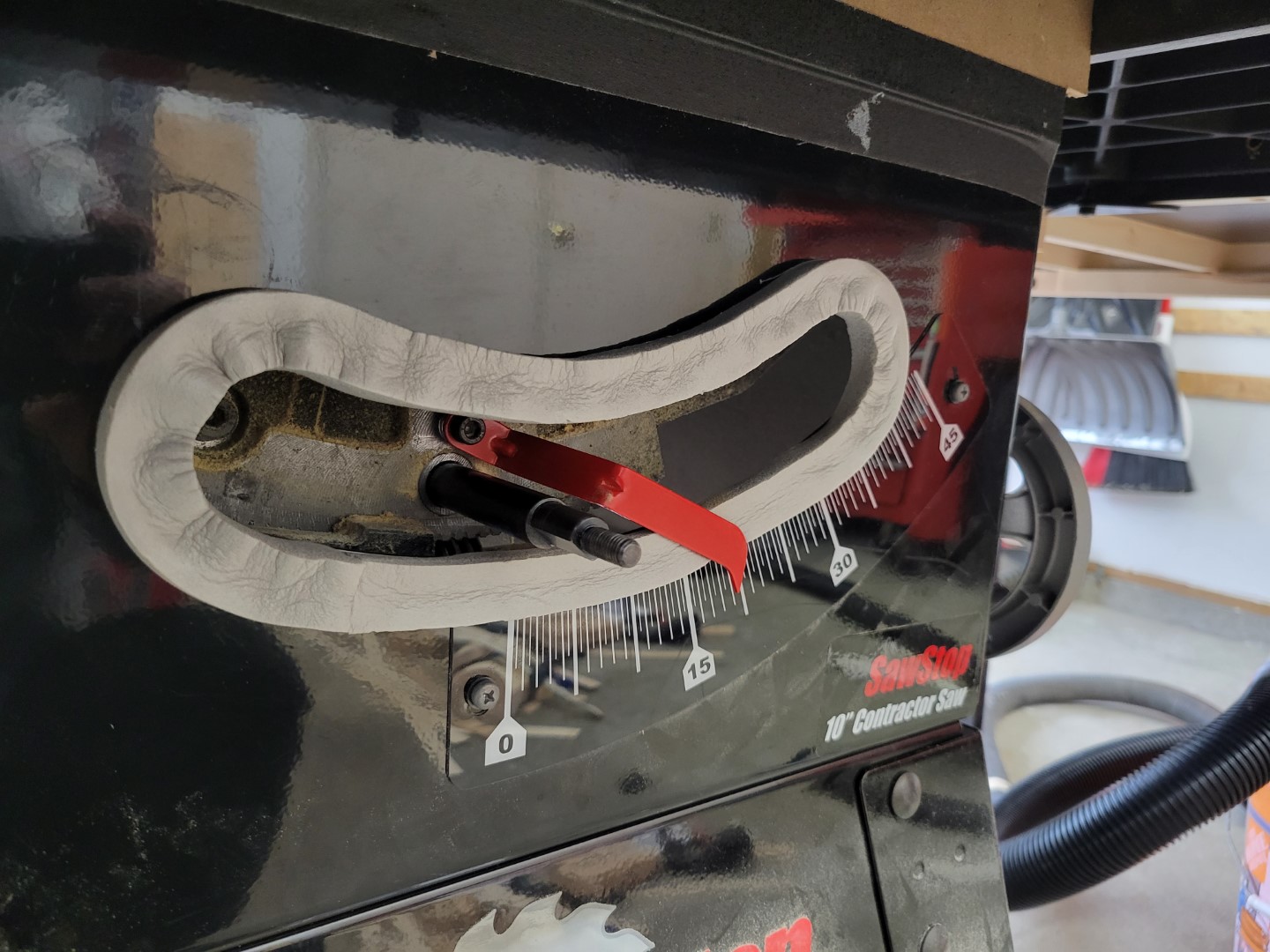
Put the foam on.
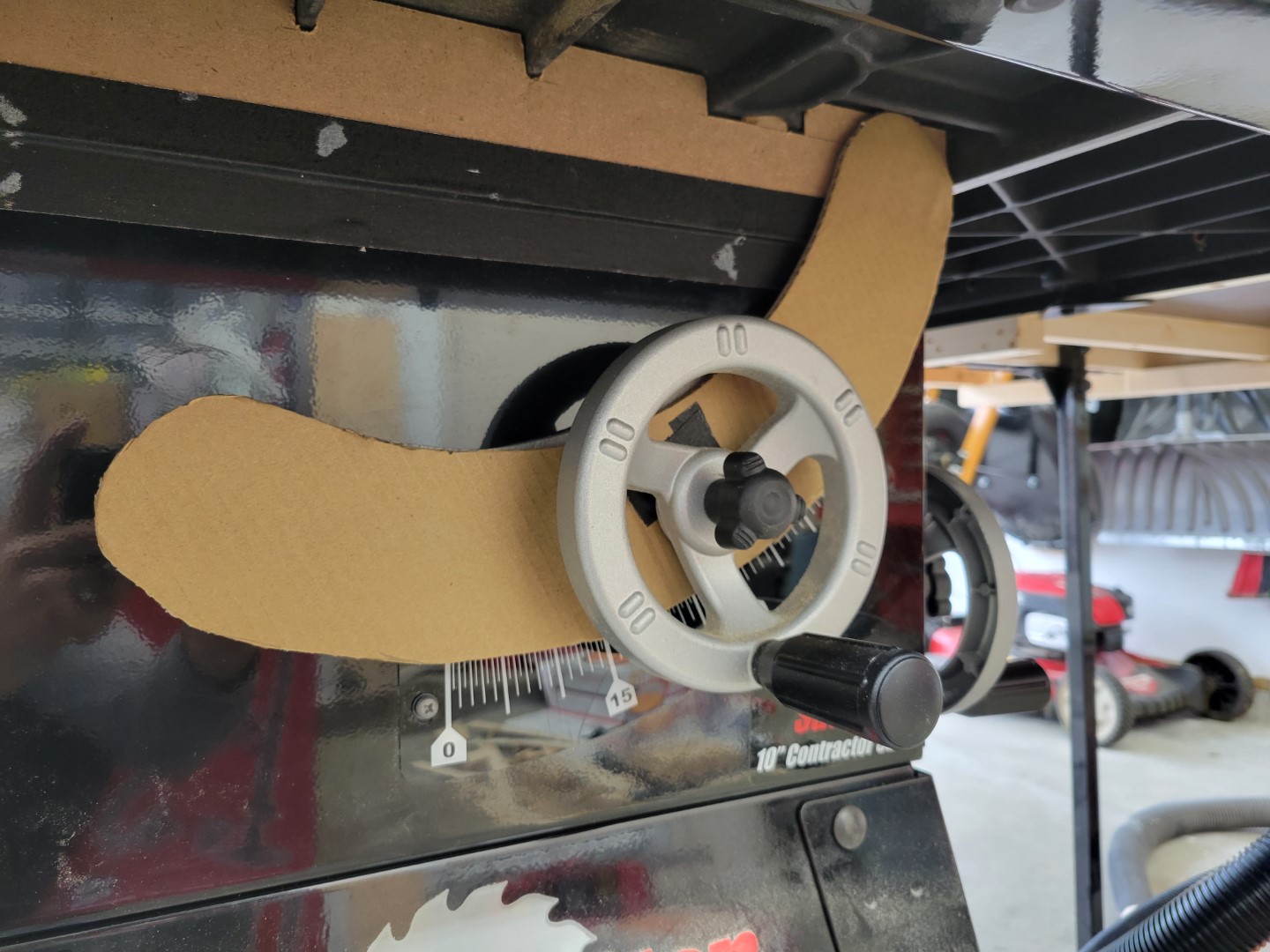
Tested with carboard.

Cut out fiberboard with a coping saw.
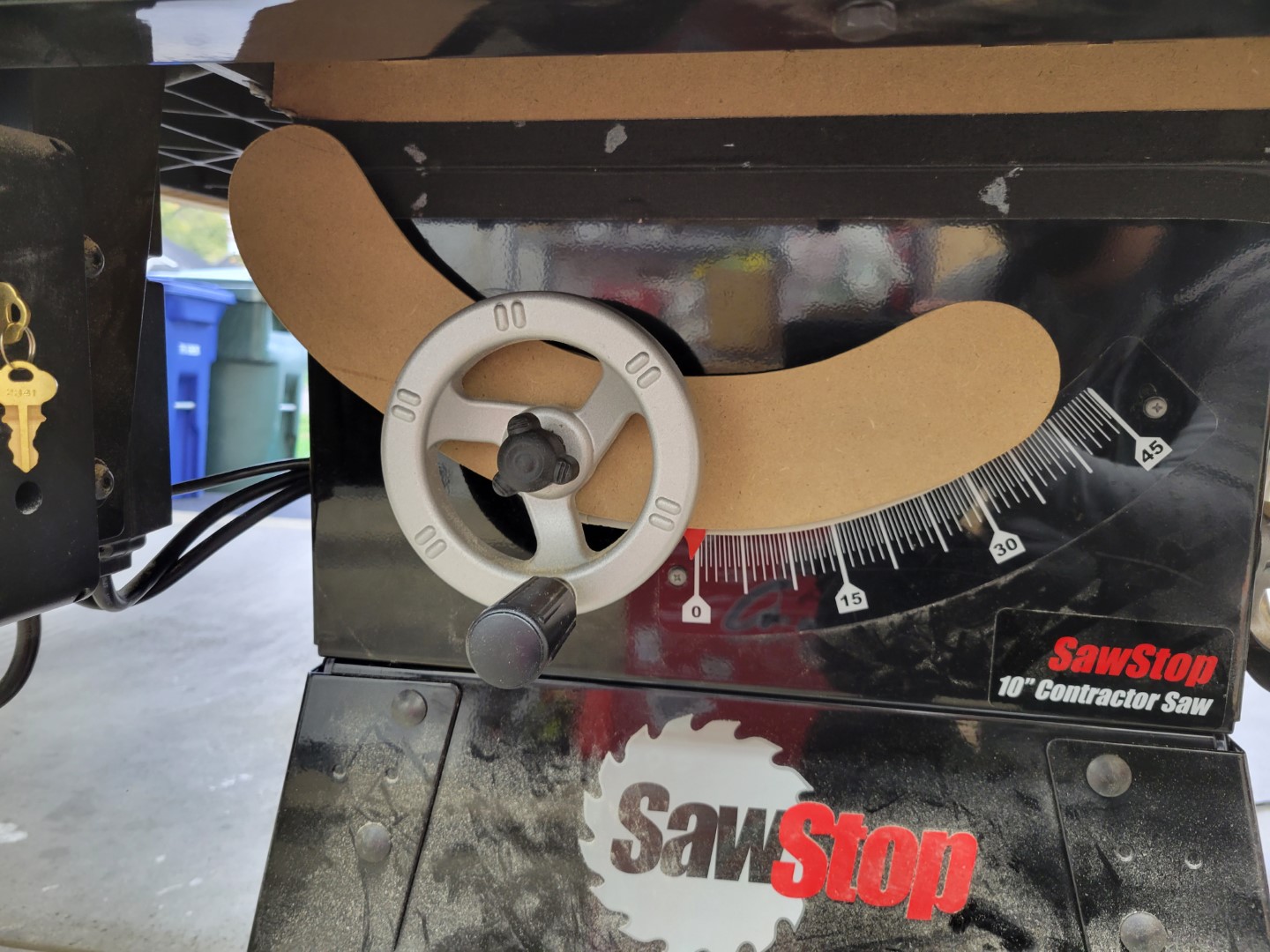
The fiberboard installed at 0 degrees tilt.
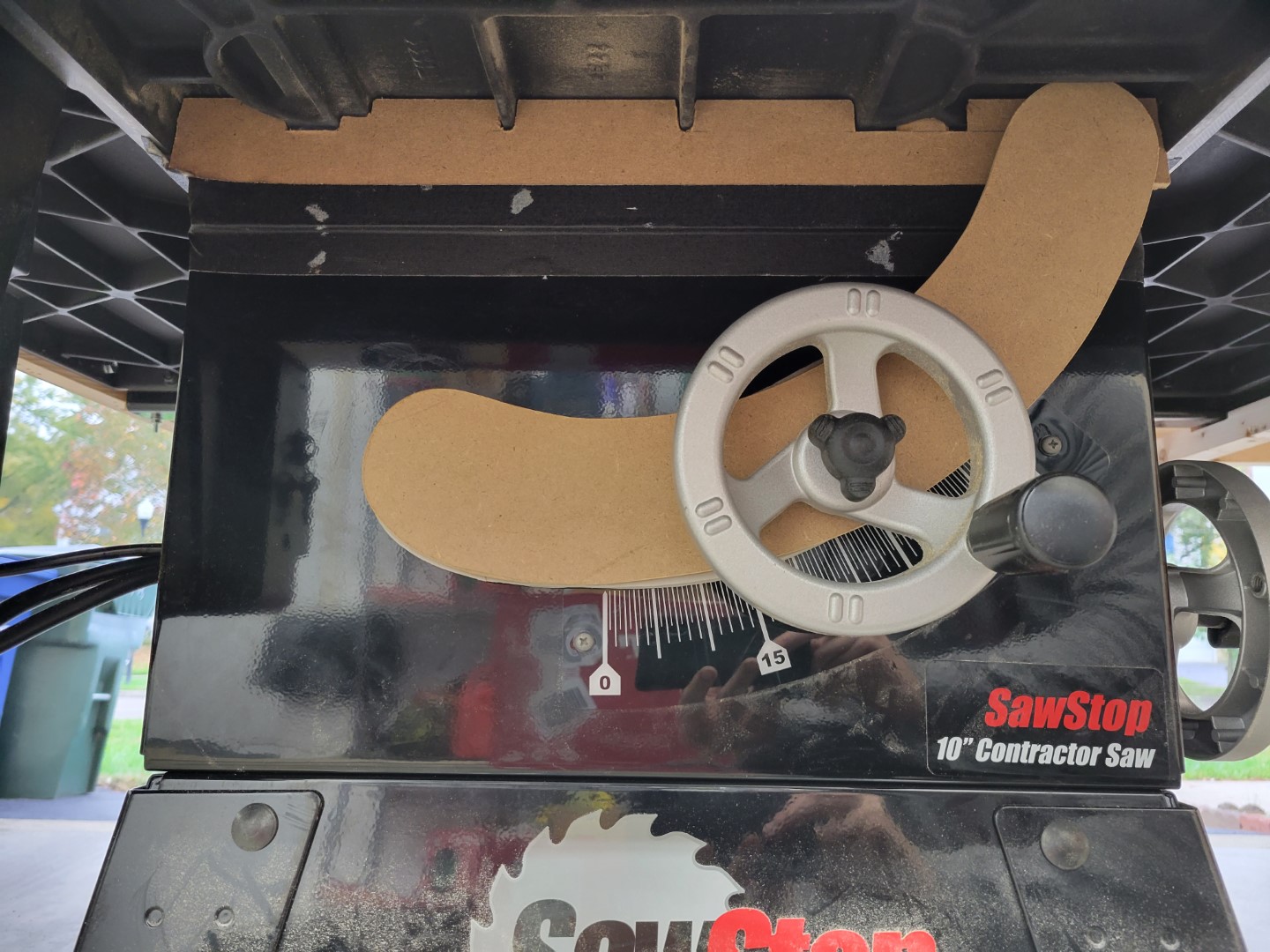
Fiberboard installed at 45 degrees tilt. I put a knick in the end because I didn’t carefully align the cover as I changed the angle, and it slipped and dug into a corner.
Which lead me to the next problem: Avoiding floppiness. Nobody wants floppyness.
I had scrap wood laying around, and tape! Needed a flat thin-ish (metric) face to tape, and some edge to keep the cover in place.
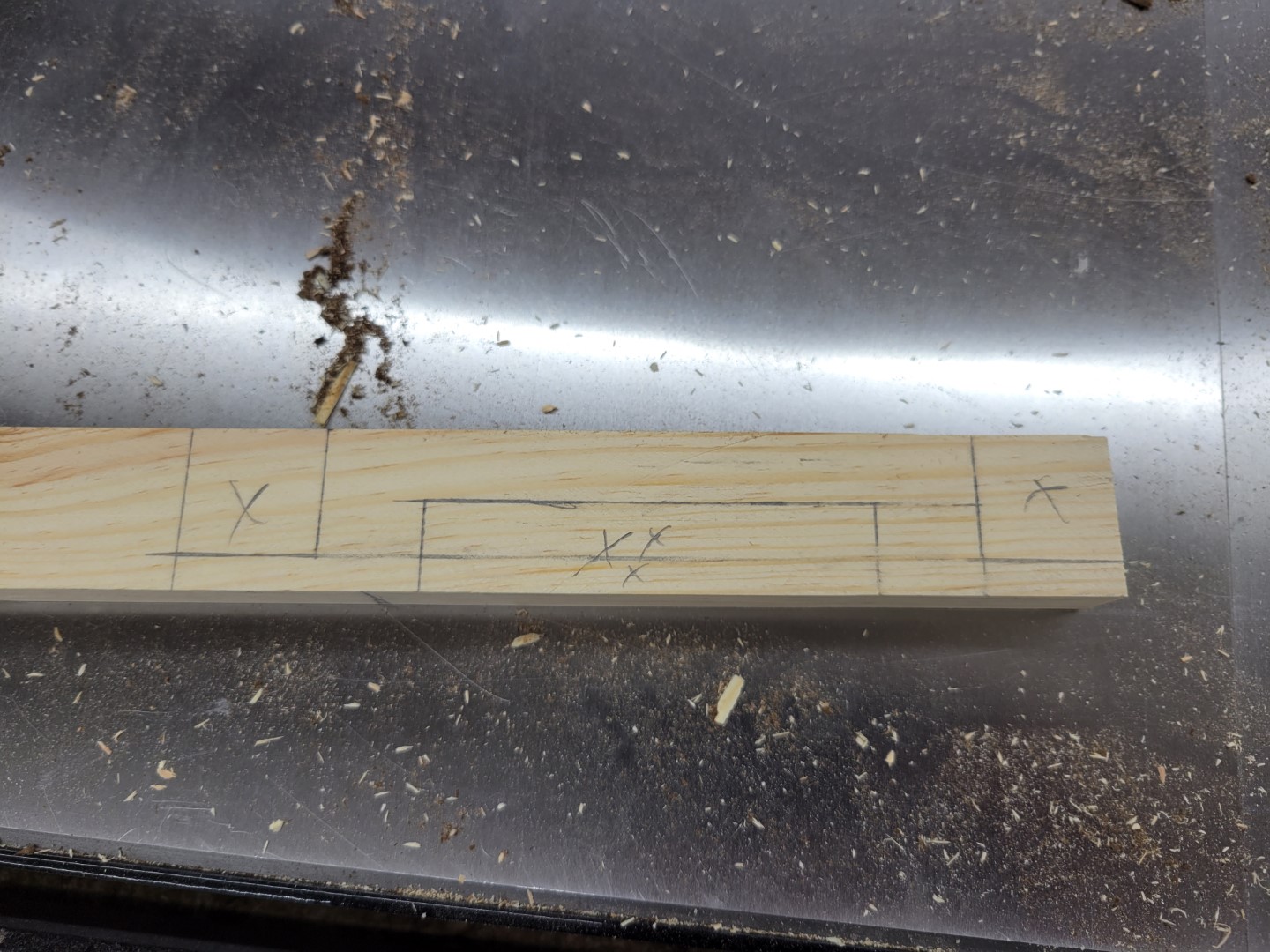
Or, maybe a whole bridge. Easy enough, I have a table saw after all.
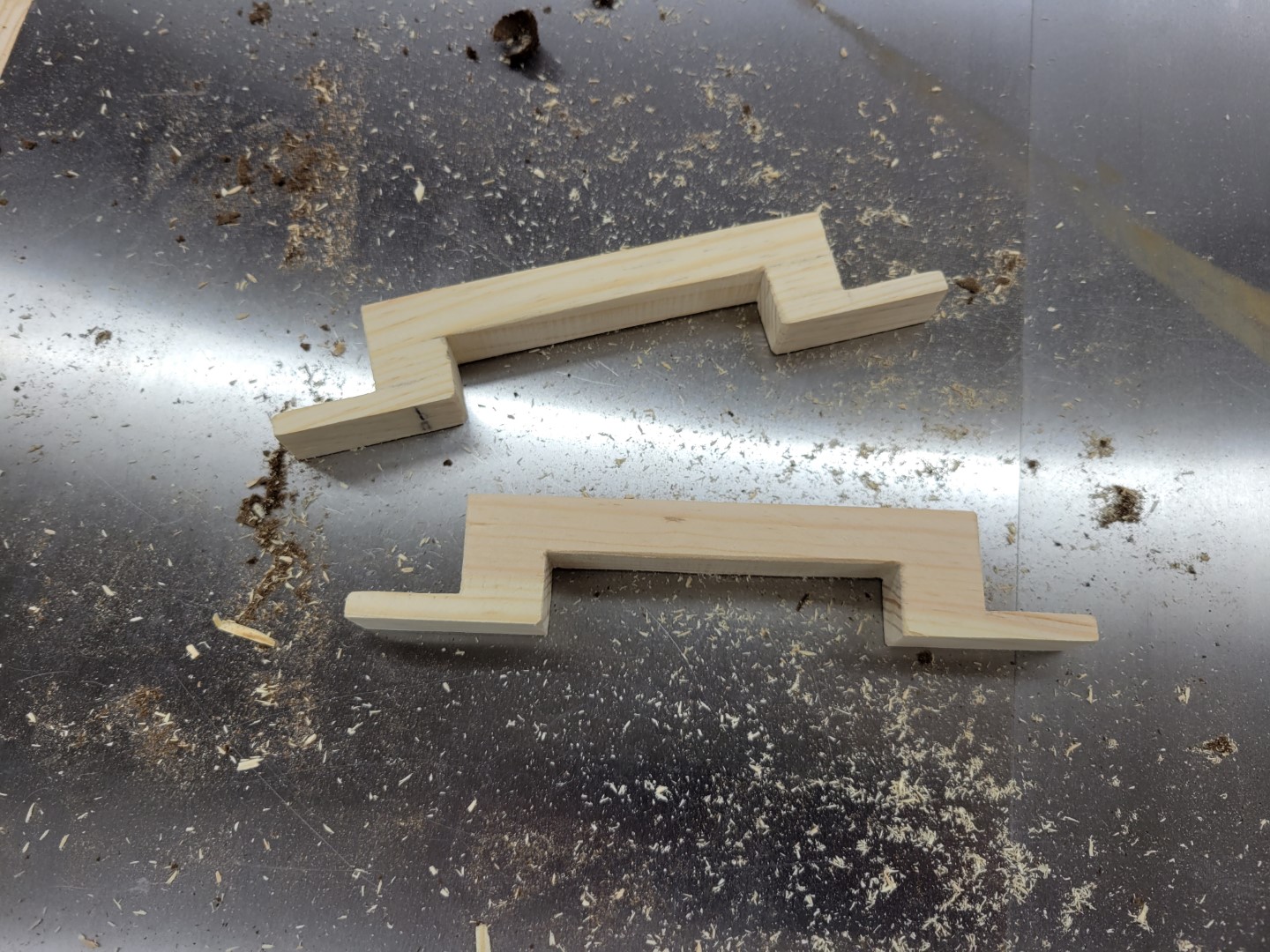
Cut out with multiple passes using the miter gauge and my eyes (not as painful as it sounds).
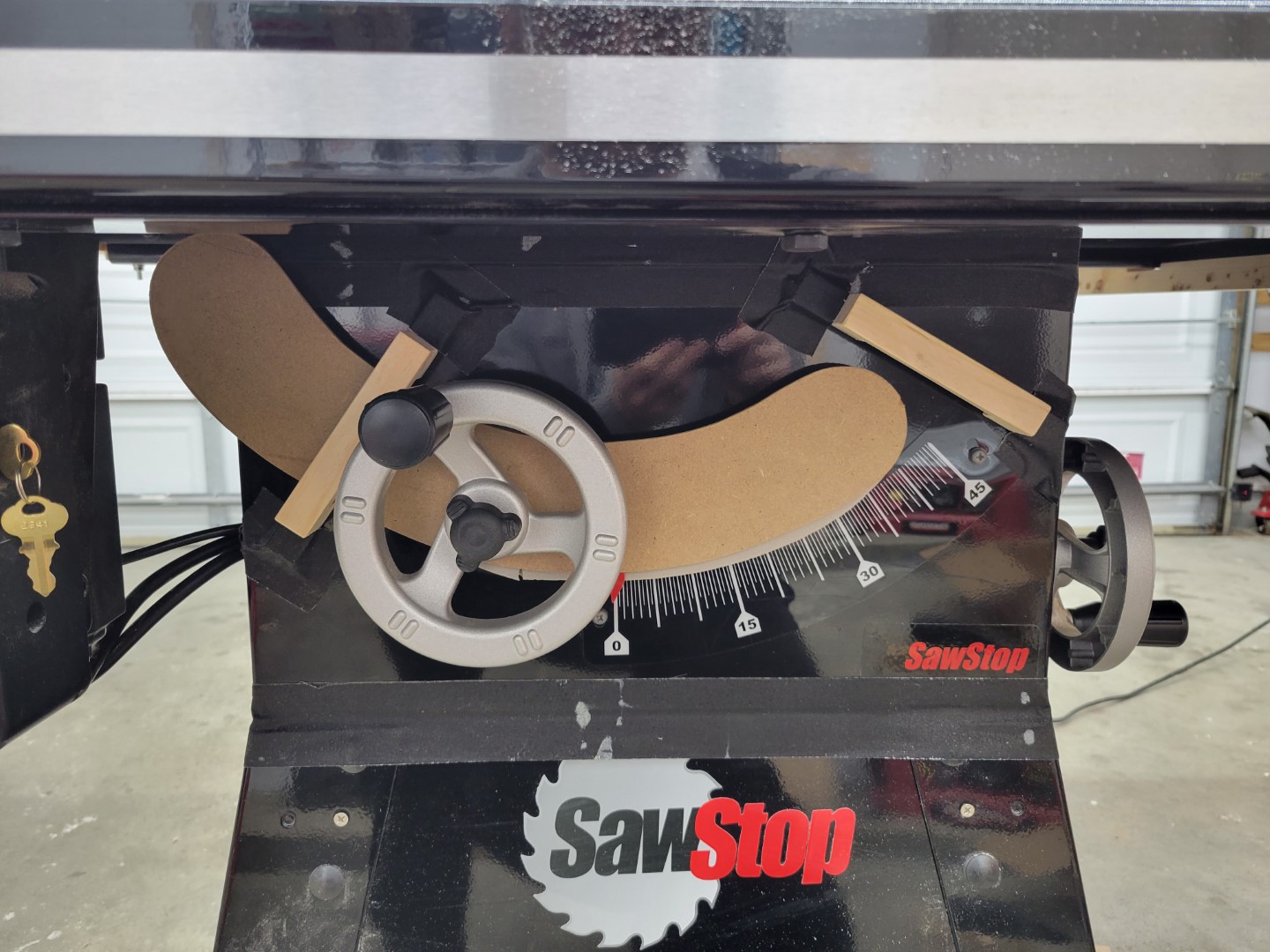
Mounted with the always-handy tape. I should buy some magnets, those would be way cooler.

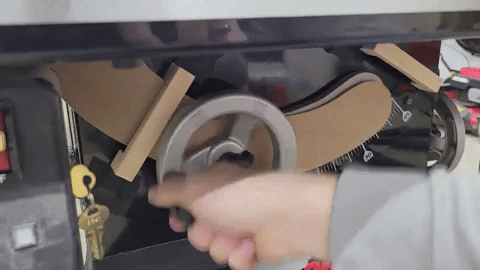
It works pretty well!
Top edge of table saw body and cast iron table
Left and right
Tape bridged the gap betweeen the saw body and the raised edge mated with the wings.
Front
Irregular shape, and bigger gap.
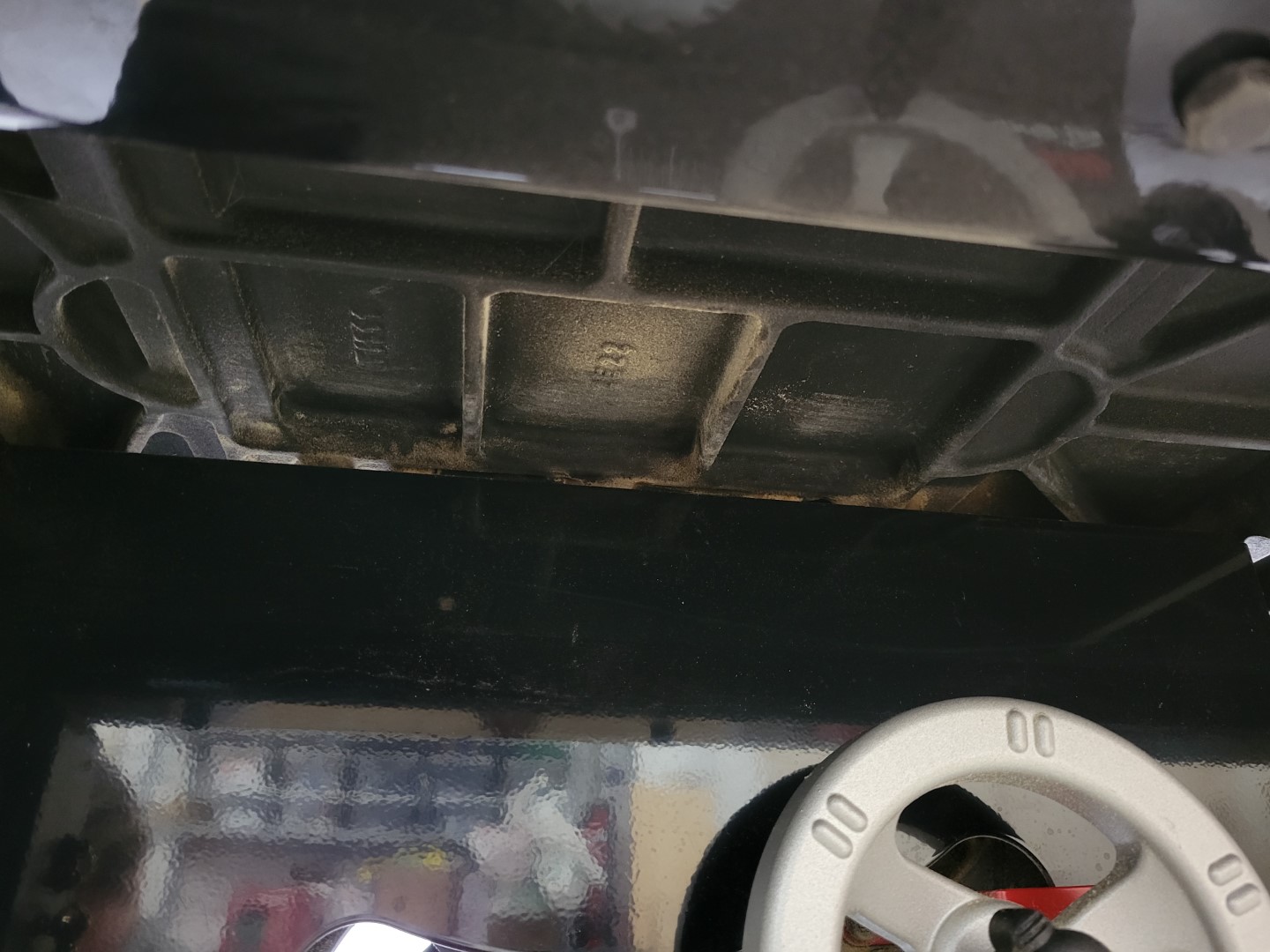
Coped out another piece of fiberboard
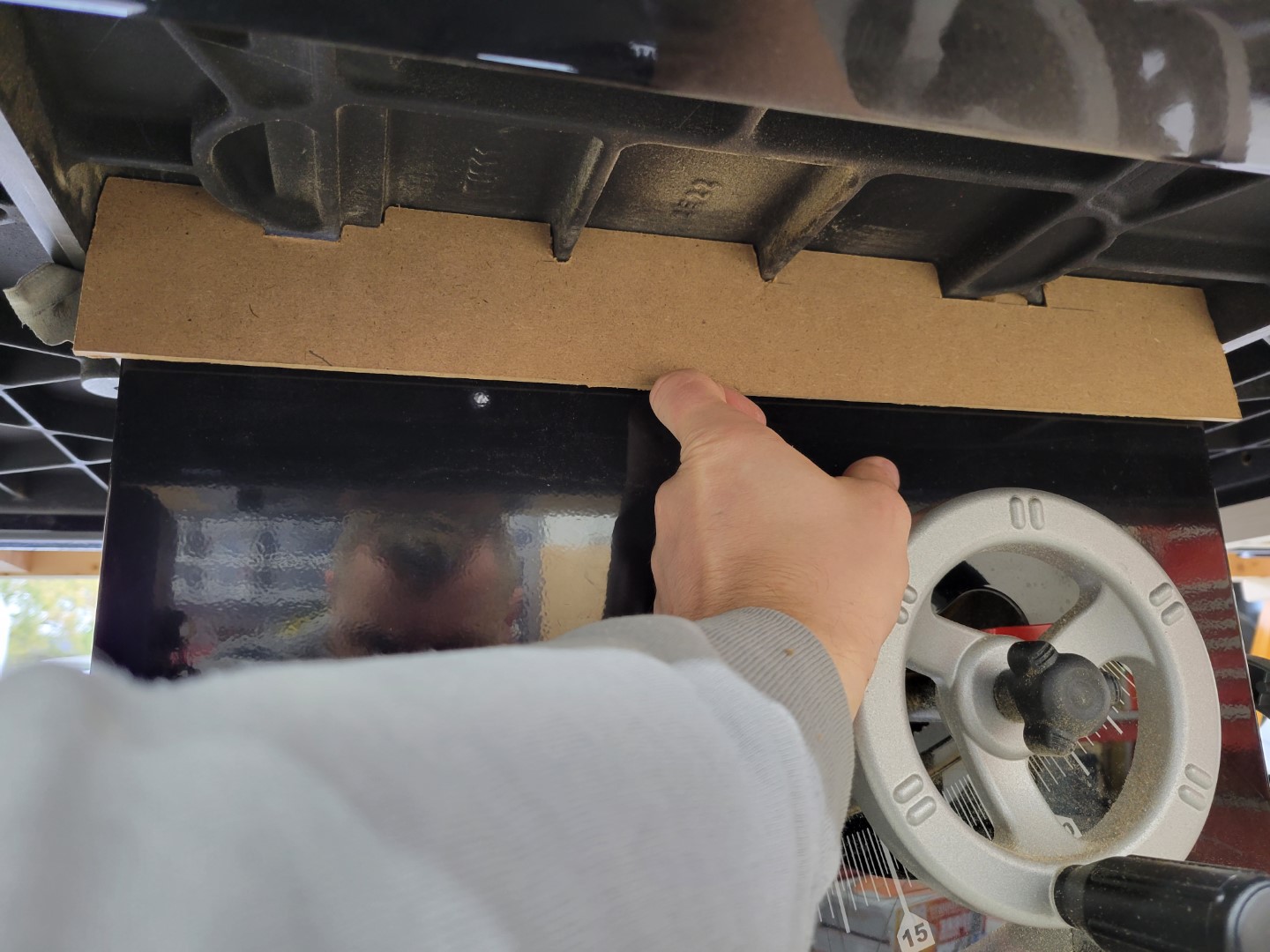
Bottom
There’s still a gaping hole here, which is the entire bottom of the saw.
Seems easy, just cut a square piece and put it in there.
But the blade shroud gets in the way. There’s a nice big warning saying not to remove it, so I’ll listen this time. Also I don’t want to figure out what to do with it if I do remove it.
So we need a bottom, but lower.
I built a frame. cut the outside edge at the same angle as the legs, and mitered the corners at 45. The legs are at a 10 degree angle, found with my super-accurate plastic protractor.
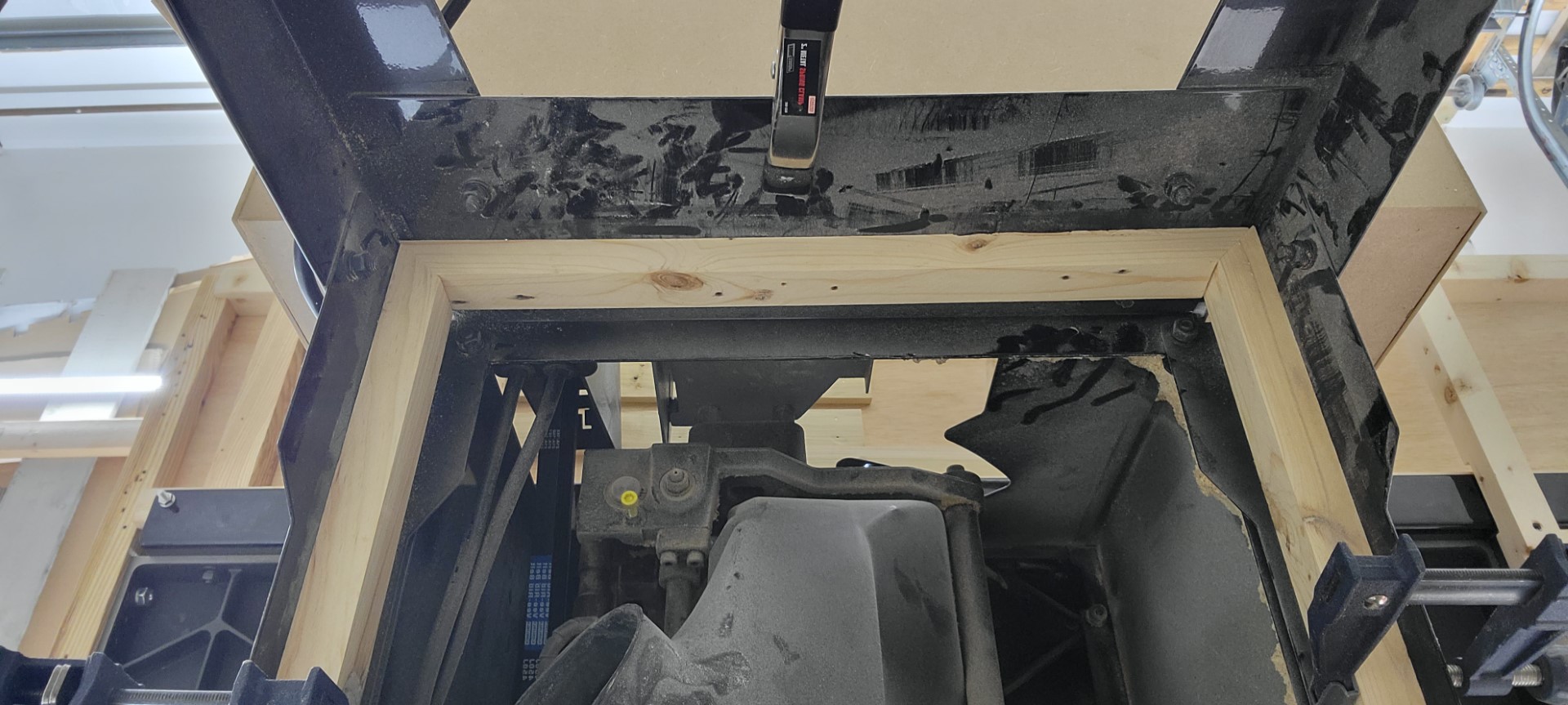
This conveniently lines up with this hole. I don’t know what it’s for but I’ll take it. Still had to drill through the sheet metal but that was fairly quick.
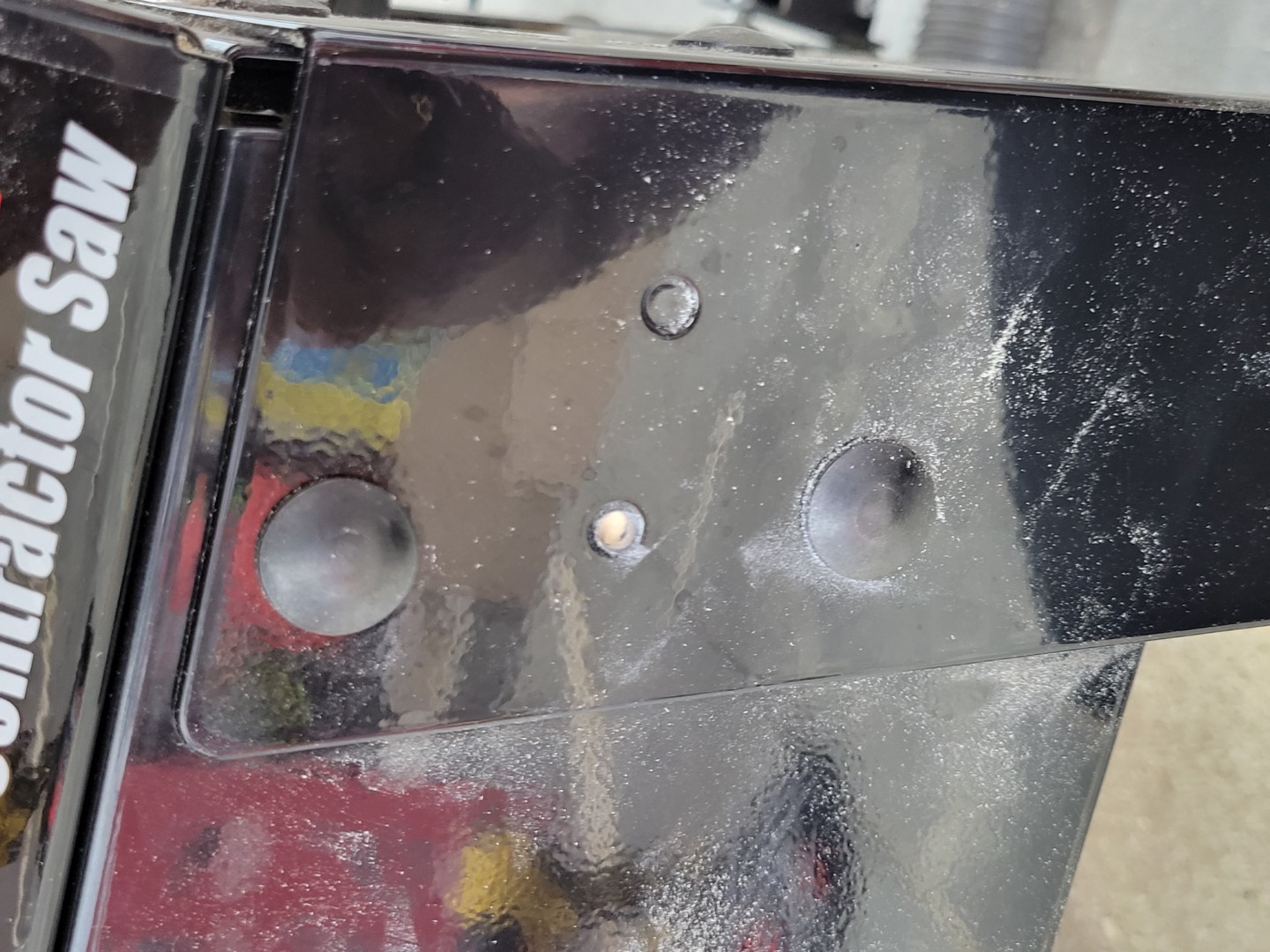
Attached with a door hinge screw.
For positioning, I had to move my frame to touch the bottom bolt to give me enough clearance for the dust shroud.
Next is the bottom face, mocked up with cardboard to get the measurements. Getting a tape measure in there was really annoying.
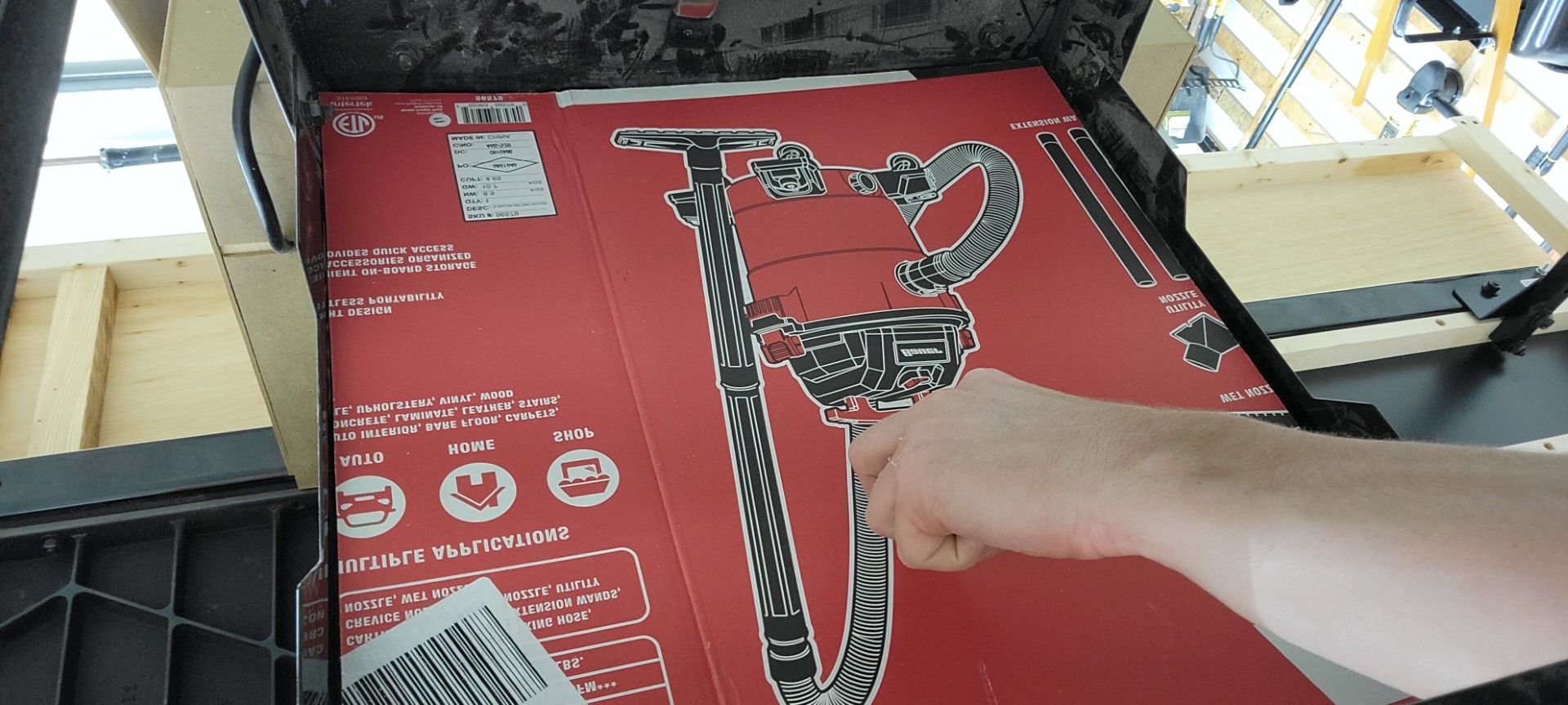
Can you guess what I recently purchased?
Recreated in fiberboard
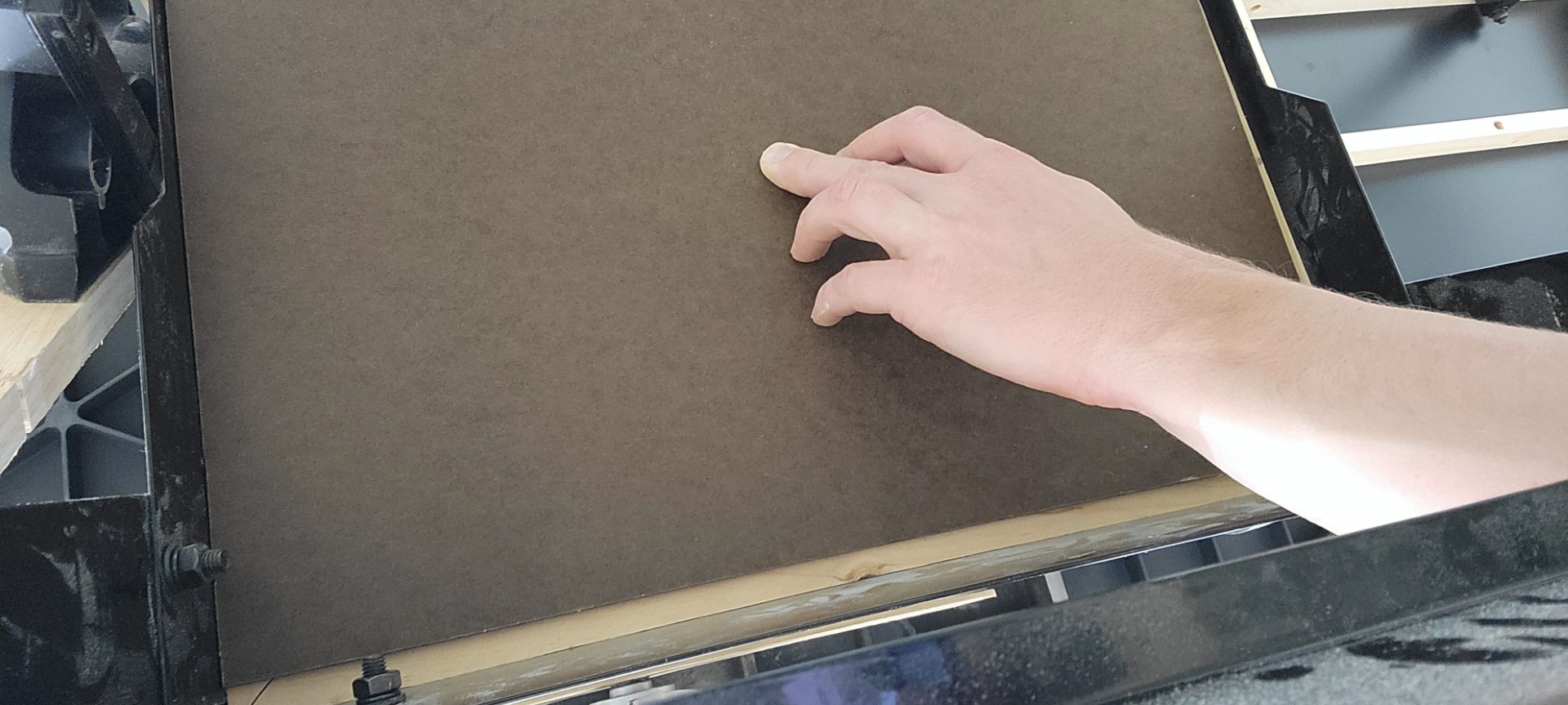
Then I 3d printed a hose adapter, cut out a hole as neatly as I could, and screwed it in.
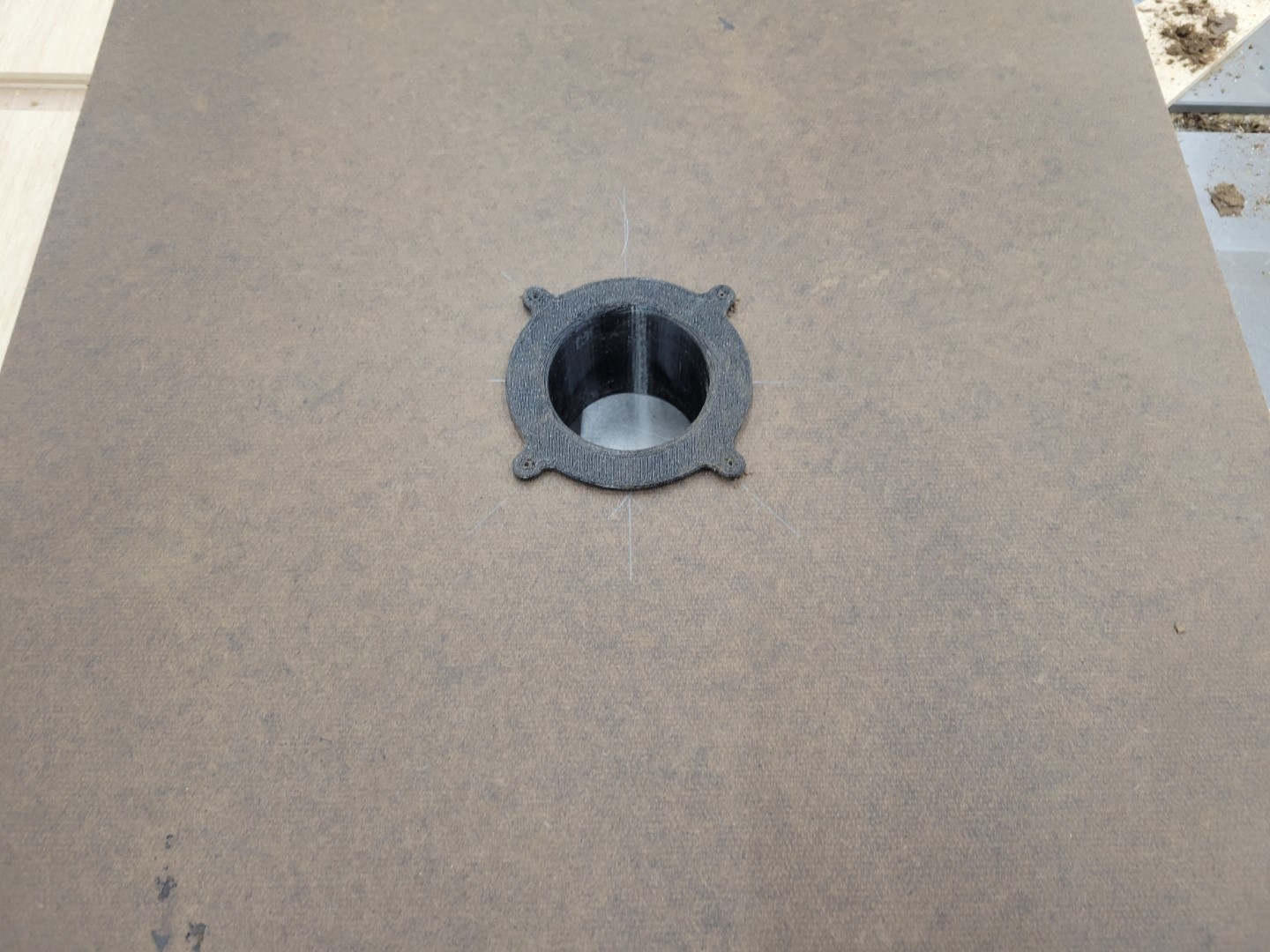
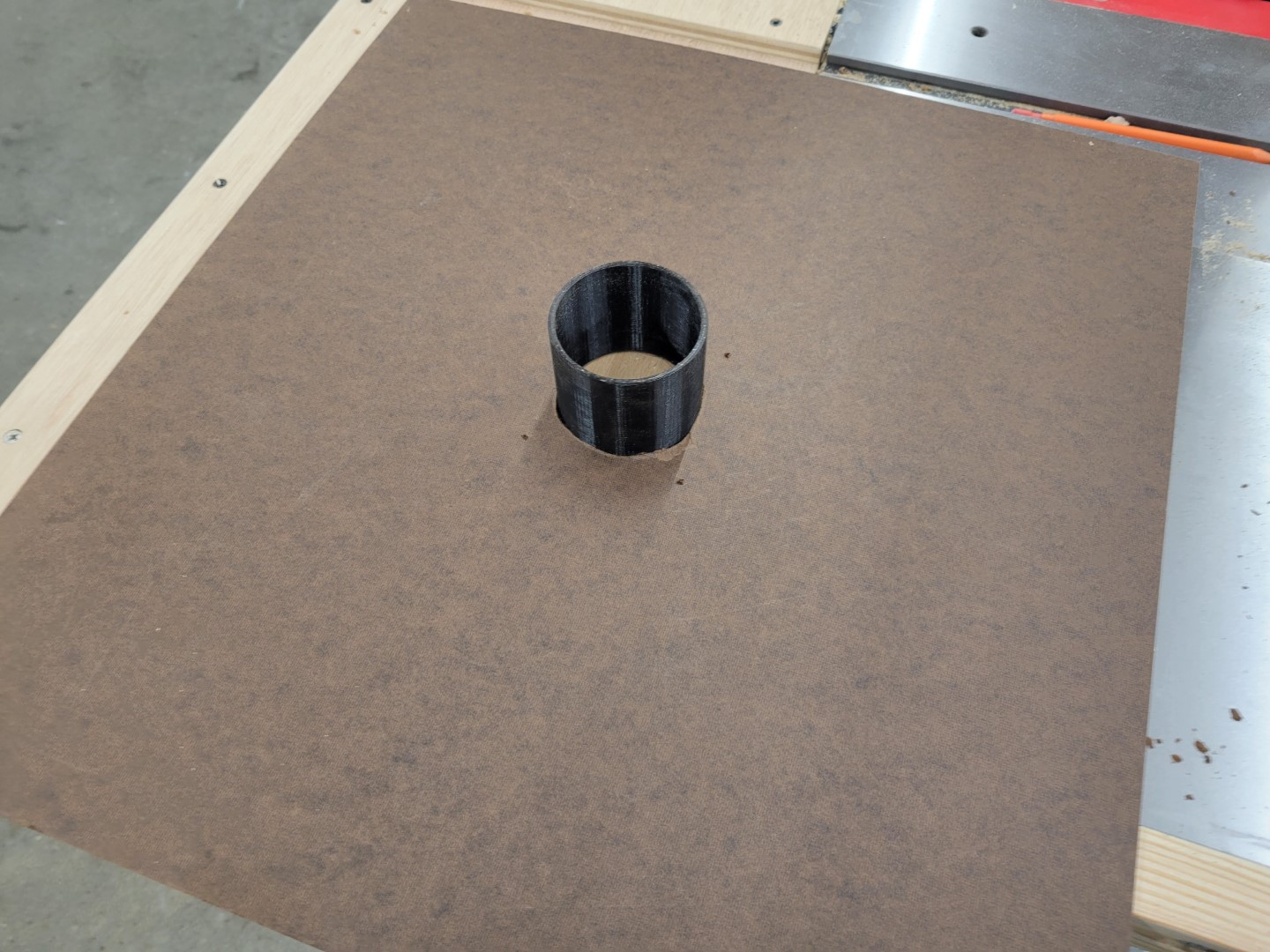
At this point I realized I didn’t leave enough clearance for the blade dust collection shroud. Had to go back and move the frame downward, and also trim about a quarter inch off the very bottom of the shroud with some snips.
Miscellaneous gaps
Switch wires
Wrapped with tape
Gap between saw body and legs
Wrapped with tape
Conclusion
The outfeed table definitely works. Even the extra foot helps when cutting a piece over two feet long. I don’t have to crank down on it to keep it from falling off the back. For longer cuts I still use an outfeed roller. An 8ft outfeed table would be best of course, but I need to use my space carefully.
The dust collection works, and keeps most of the dust contained. Some still spills out toward me from the top of the blade.
I used a harbor freight shop vac ($90 with coupon) and a dustopper ($60) on an old bucket. Only complaint is the volume.
I did run into the issue identified on the shophacks website where the airflow is too restricted, sawdust builds up in the air inside the body, and gets spit out the throat plate. This happened when I made a 2-3 inch thick rip of a 3ft board. I drilled two holes in the back of the box near the motor to add some cooling fresh air for the motor to avoid overheating. This should also keep the dust concentration down. Will drill more if necessary.
I’ll keep an eye out for sawdust buildup in the body, I noticed some, but it might stay constant once a certain amount piles up.
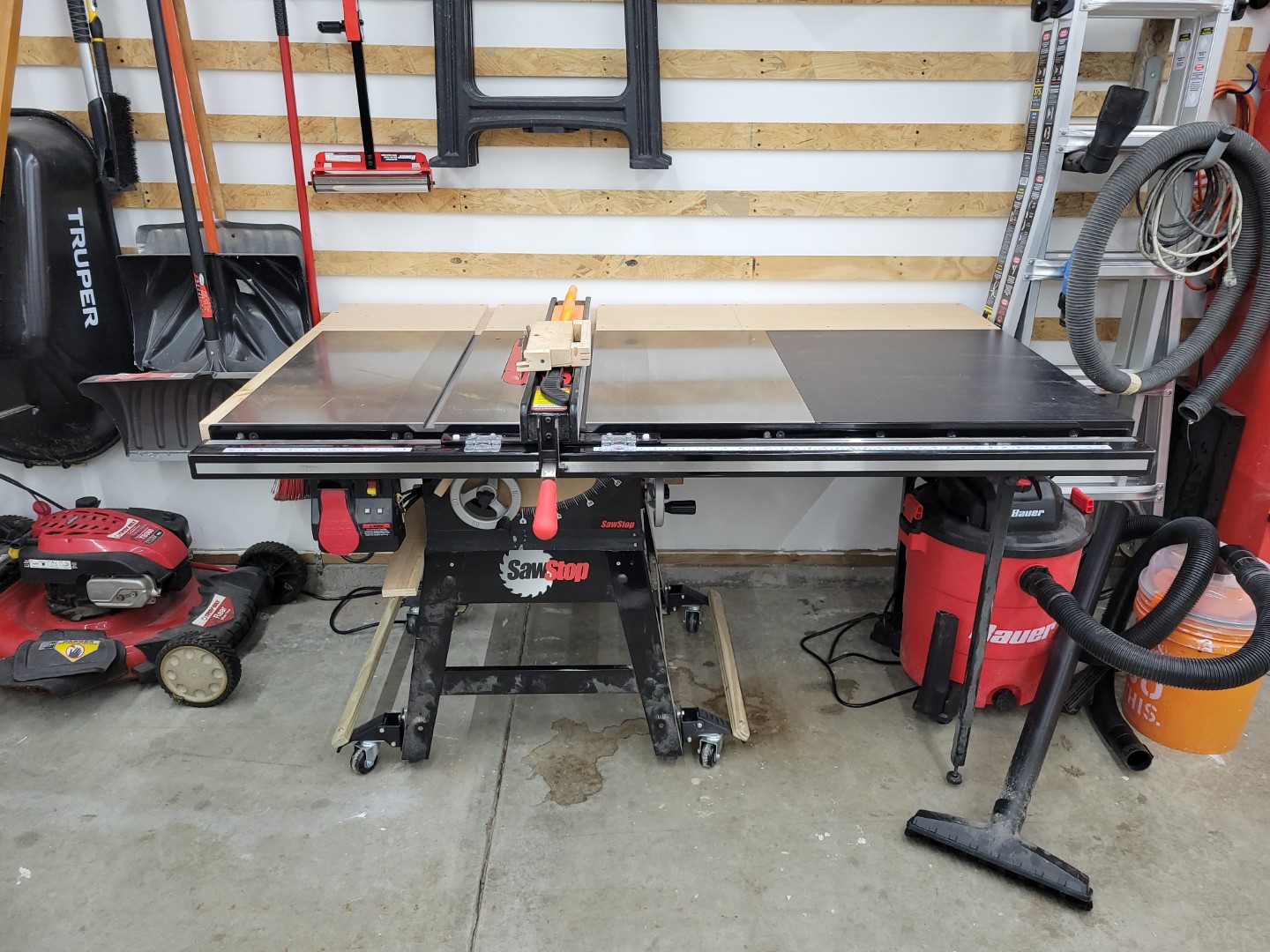
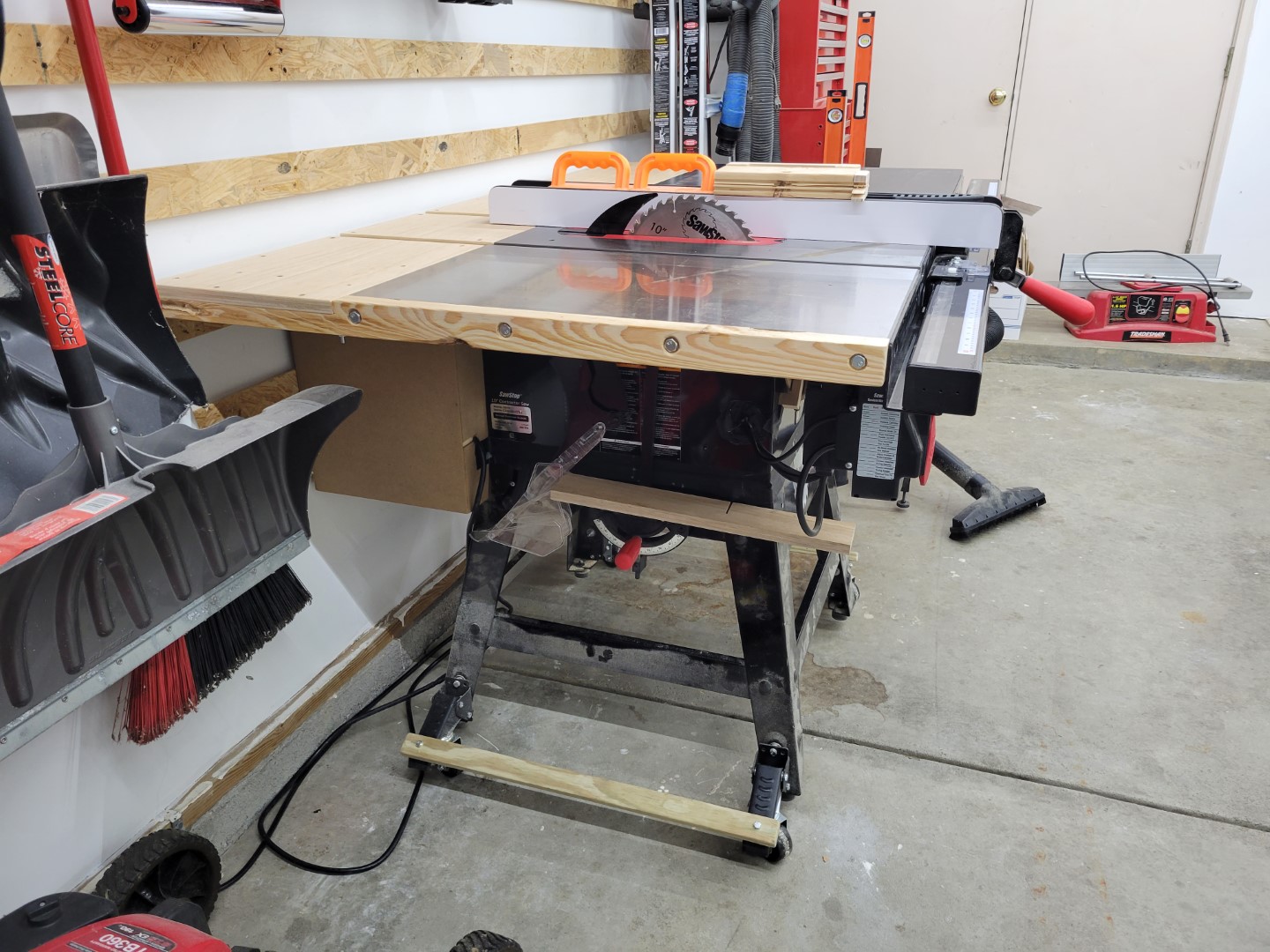
The table saw takes up exactly the same amount of space as before, but has a few new features.
